Vineet Aggarwal's Blog, page 2
November 22, 2014
Vishwamitra - The Man who dared to challenge the Gods!
Alright so a lot of people have been asking why I haven't been active on the blog since more than a year and I am glad to say that finally I can share the answer with you guys!! As you might know I have a full-time job and whatever spare time I got was being used for my book which is coming out by the end of this month!
So I thank all of you who have been posting comments and sharing ideas all this while and I have made sure I replied to your comments and suggestions even if I couldn't devote enough time for a new article! Here's the cover of my soon-to-be-launched book which is a fictional account of the story of Brahmarishi Vishwamitra.

For any writer, his first book holds special value since it is as much a labor of love and sweat as an exercise in discovering one’s own latent potential and this book is my labor of love and sweat in more ways than one.
Vishwamitra isn’t a religious book, nor a book on spirituality. It’s neither completely fiction nor entirely based on reality. Yet, it holds an important message, for it is the life story of an ordinary human who rose above the confines of his physical and mental boundaries to fight fate and take charge of his own destiny.
Unlike the Devas, Gandharvas, Vidyadhars, Siddhas, Arihants, Bodhisattvas and other assorted divine beings from our scriptures, we, the ordinary Manavs (the Sanskrit term for Man) are considered to have limited capabilities. Yet, we see people in a variety of disciplines seeking to breach that barrier every day. These are the people who challenge the norms set by the society and set new milestones for the rest of mankind. This story is an ode to one such man.
Vishwamitra’s life is the perfect example of how far a man can go in order to obtain what he truly desires. Many may know of him as one of the greatest rishis of Vedic times and some may even remember the role he plays in the Ramayan. But even those who are familiar with his name may not know that Vishwamitra was born a prince and became a Brahmarishi purely by virtue of his own efforts. You may be further surprised to know that he is also the discoverer of the Gayatri Mantra, the most popular hymn chanted by millions of Hindus all over the globe every day.

Born into a Kshatriya family, divine providence blessed him with a potent spiritual streak that fuelled his quest to become the highest of the high priests of ancient India. History identifies him as the only Kshatriya king to have achieved the impossible task of becoming a Brahmarishi and recognizes him as the human architect of no less than a star system!
This book is a chronicle of the trials and tribulations faced by a man torn between duty and desire, and the vicissitudes and failings of human condition. Yet, at its heart, it is a story of HOPE - hope that makes a human being challenge his destiny with random acts of free will; hope that makes a king leave all his possessions and turn into a hermit; hope that fuels the desire for being remembered in spirit, even after the body has perished in dust.
This, thus, is the narrative of a brave king of Aryavarta, who not only
attained fame through his military conquests but, through his intense
spiritual quest, also became one of the most well-known sages of all
time. It is the story of a man who dared to challenge the gods.
I also hope to bring more such hidden stories from our mythologies to my dedicated audience and I sincerely HOPE you guys like the book! Sharing the flipkart and amazon links for your convenience:
1. FLIPKART
2. AMAZON.in
3. KINDLE version

May Brahma-rishi Vishwamitra's blessings be with us all!
Aum Shanti: Shanti: Shanti:
So I thank all of you who have been posting comments and sharing ideas all this while and I have made sure I replied to your comments and suggestions even if I couldn't devote enough time for a new article! Here's the cover of my soon-to-be-launched book which is a fictional account of the story of Brahmarishi Vishwamitra.

For any writer, his first book holds special value since it is as much a labor of love and sweat as an exercise in discovering one’s own latent potential and this book is my labor of love and sweat in more ways than one.
Vishwamitra isn’t a religious book, nor a book on spirituality. It’s neither completely fiction nor entirely based on reality. Yet, it holds an important message, for it is the life story of an ordinary human who rose above the confines of his physical and mental boundaries to fight fate and take charge of his own destiny.
Unlike the Devas, Gandharvas, Vidyadhars, Siddhas, Arihants, Bodhisattvas and other assorted divine beings from our scriptures, we, the ordinary Manavs (the Sanskrit term for Man) are considered to have limited capabilities. Yet, we see people in a variety of disciplines seeking to breach that barrier every day. These are the people who challenge the norms set by the society and set new milestones for the rest of mankind. This story is an ode to one such man.
Vishwamitra’s life is the perfect example of how far a man can go in order to obtain what he truly desires. Many may know of him as one of the greatest rishis of Vedic times and some may even remember the role he plays in the Ramayan. But even those who are familiar with his name may not know that Vishwamitra was born a prince and became a Brahmarishi purely by virtue of his own efforts. You may be further surprised to know that he is also the discoverer of the Gayatri Mantra, the most popular hymn chanted by millions of Hindus all over the globe every day.

Born into a Kshatriya family, divine providence blessed him with a potent spiritual streak that fuelled his quest to become the highest of the high priests of ancient India. History identifies him as the only Kshatriya king to have achieved the impossible task of becoming a Brahmarishi and recognizes him as the human architect of no less than a star system!
This book is a chronicle of the trials and tribulations faced by a man torn between duty and desire, and the vicissitudes and failings of human condition. Yet, at its heart, it is a story of HOPE - hope that makes a human being challenge his destiny with random acts of free will; hope that makes a king leave all his possessions and turn into a hermit; hope that fuels the desire for being remembered in spirit, even after the body has perished in dust.
This, thus, is the narrative of a brave king of Aryavarta, who not only
attained fame through his military conquests but, through his intense
spiritual quest, also became one of the most well-known sages of all
time. It is the story of a man who dared to challenge the gods.
I also hope to bring more such hidden stories from our mythologies to my dedicated audience and I sincerely HOPE you guys like the book! Sharing the flipkart and amazon links for your convenience:
1. FLIPKART
2. AMAZON.in
3. KINDLE version

May Brahma-rishi Vishwamitra's blessings be with us all!
Aum Shanti: Shanti: Shanti:
Published on November 22, 2014 07:21
June 1, 2013
U.F.Os and Vimanas
O Rama of unequaled prowess,
This aerial car shining like the sun,
Moves as
one pleases, wonderful and excellent;
This Pushpak of Kuber, robbed by
Ravan in battle,
Is retained here for your
sake;
The yonder aerial car, looking like a cloud,
Stands here and by which transport,
You can reach Ayodhya without any trouble.
May prosperity attend you!
- Valmiki Ramayan [6.121.9-11]
The above verse describes the Pushpak Vimaan, perhaps the most famous airship mentioned in the ancient Hindu literature. Many Sanskrit epics contain references to such flying machines called the Vimaans/Vimanas. These Vimaans were said to be able to
travel into space between different planets and were used by various denizens of the higher Lokas. In this post, we shall analyze the evidence in favor of such flying machines being available to the ancients and their similarities to the modern aircrafts.
Vimaans in literature
There are
many descriptions of flying machines that broadly fall into two categories:
(1) Manmade aircrafts that
resemble our modern airplanes, and
(2) Alien structures that are
generally built by either the architects of Devas or Asurs and resemble the modern perception of UFOs.
The FIRST of this category are
described mainly in medieval Sanskrit literature dealing with
architecture, siege engines, and other mechanical
contrivances. Those in the SECOND category are described in ancient works such
as the Rig Veda, the Mahabharat, Ramayan, and various Puraans, and have many features reminiscent of UFOs.

We will deal with the second category first as their references are more in number, and seem to be more authentic as well. Perhaps everyone who knows anything about Hinduism, or has heard/read the Ramayan, would know about Pushpak Vimaan, the aircraft which belonged to Ravan, the king of Lanka.
Not many, however, would have heard about the architect of this aircraft - Maya Danav.
Maya, the gifted Asur conjurer
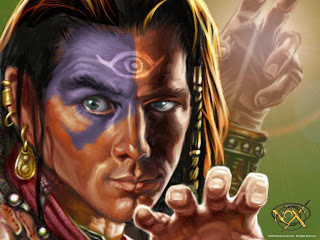
Maya was the foremost of architects among the Asurs and a formidable rival to Vishwakarma, the architect-of-the-gods. He was the father-in-law of Ravan and is credited with marvelous feats of engineering performed not only for the demons but also for Devas and humans. To list a few of these, Maya built the:
Three flying cities of Tripura for the sons of Tarkasur,
The island city of Lanka for Kuber and
the Palace-of-illusions for the Pandavs at Indraprastha.
Besides these architectural wonders, he also wrote the astronomical treatise called the 'Surya-siddhant' that forms the basis of Indian astronomy even today! Combining his knowledge of all these principles, he perhaps took the next step and created the flying vehicles or Vimaans. Maya himself, is believed to have possessed a Vimaan measuring twelve cubits in circumference, with four strong wheels.
The Pushpak Vimaan
Pushpak was originally designed for Kuber, the god-of-wealth, but was usurped by his half-brother, Ravan along with his island city of Lanka. There are various passages in the Ramayan that talk about the wonderful qualities of this aerial vehicle:
कांचनम् रथम् आस्थाय कामगम् रत्न भूषितम् |
पिशाच वदनैः युक्तम् खरैः कनक भूषणैः || ३-३५-६
मेघ प्रतिम नादेन स तेन धनद अनुजः |
राक्षसाधिपतिः श्रीमान् ययौ नद नदी पतिम् || ३-३५-७
That chariot which is decorated with golden ornaments, yoked with monster-faced mules that have gem studded trappings is ride-able by the wish of the rider, and sitting in such a chariot which is wholly golden and which rides with a sound like the pealing of thunder, that celebrated Ravan, the brother of Kuber and the lord of demons, traveled towards the lord of rivers and rivulets, namely the ocean.
So, the Pushpak was an aerial vehicle, navigable by thought, shimmering like the Sun, with a thunderous noise and could travel anywhere across the globe. Sounds like a cross between a UFO and one of our modern supersonic planes!
An alleged UFO sighting in Mexico

The special characteristic of this vehicle seems to be that whatever may be the number of people sitting inside the plane, there would always be one seat vacant! In other words, if N number of people want to board the plane, there would still be (N+1) seats available. This prodigious capacity is mentioned to in the following verses:
प्रियाअत्प्रियतरं लब्धं यदहं ससुहृज्जनः || ६-१२२-२२
सर्वैर्भवद्भिः सहितः प्रीतिं लप्स्ये पुरीं गतः |
Shri Raam said - Something more dearer than everything dear will be achieved by me, if I reach Ayodhya with the host of my friends along with all of you, for, I shall feel delighted.
This is when Vibhishan, the brother of Ravan and the newly crowned king of Lanka tells the Lord, that the aircraft can carry as many people as the Lord would want to accomodate!
ततह् स पुष्पकं दिव्यं सुग्रीवः सह वानरैः || ६-१२२-२४
आरुरोह मुदा युक्तः समात्यश्च विभीषणः |
Thereupon, that Sugreeva along with the monkeys gladly ascended that wonderful Pushpaka, the aerial car. Vibhishan together with his counselors also ascended it.
तेष्वारूढेषु सर्वेषु कौबेरम् परमासनम् || ६-१२२-२५
राघवेणाभ्यनुज्ञातमुत्पपात विहायसम् |
When all of them ascended, that excellent aerial car, belonging to Kuber, flew into the sky, after having been duly authorized by Rama.
Pushpak Vimaan - Pahari miniature painting

खगतेन मिवानेन हंसयुक्तेन भास्वता || ६-१२२-२६
प्रहृष्टश्चप्रतीतश्च बभौ रामः कुबेरवत् |
Feeling greatly rejoiced and satisfied while travelling in that splendid aerial car, which was now in the air and was provided with the image of a swan, Rama shone like Kuber.
ते सर्वे वानरर्क्षश्च राक्षसाश्च महाबलाः || ६-१२२-२७
यथासुखमसंबाधं दिव्ये तस्मिन्नुपाविशन् |
All those mighty Vanars, bears and demons sat comfortably and spaciously in that wonderful aerial car.
Another such description is found in the Ayodhya Kand [XVI, pp. 235-236]-
The splendid chariot, made of silver, and bright like the fire itself, making a noise like the roaring of the clouds; defying all obstacles, adorned with jewels and gold, dazzling to the eyesight and bright, went speedily on, making space resound like unto the muttering cloud in the sky. He issued out of his abode like the beautiful moon passing through a huge cloud.
As mentioned in the post { Rama - The Historical Perspective }, in Sri Lanka, the Pushpak Viman is referred to as the Dhandu Monara or the Flying-Peacock and even today there exists a place called Weragantota in Lanka whose name implies 'The-Landing-Place-of-Aircraft'!! Not far from there is another place called Gurulupotha (parts-of-birds) where he is supposed to have the aircraft-repair center!
One of the 6 airports of Ravan - Weragantota
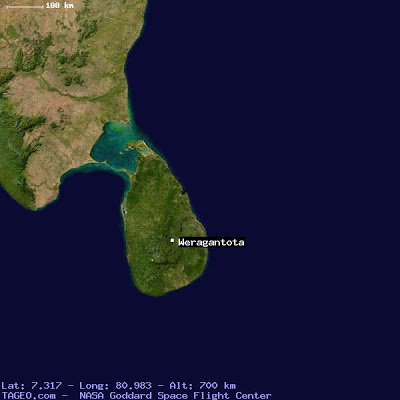
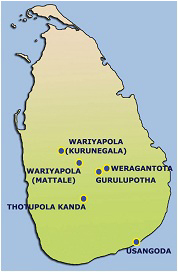
This implies that it is more than likely that the Pushpak Vimaan DID actually exist and was perhaps the last aircraft of its kind before the advent of our so called modern age.
Other References to Vimaans
The Pushpak is not the only aircraft mentioned in so much detail. The Mahabharat mentions such celestial crafts in many passages as well!
During his quest for celestial weapons before the Mahabharat War, Arjun was invited by Indra to spend some time in Amravati. Indra's charioteer Matali came to pick him up and this is how the description goes:
And on this sunlike, divine, wonderful chariot the wise disciple of Kuru flew joyously upward. When becoming invisible to the mortals who walk the earth, he saw wondrous airborne chariots by the thousands.
And the celebrated Arjun, having passed through successive regions of the heavens, at last beheld the city of Indra. And there he beheld celestial cars by thousands stationed in their respective places and capable of going everywhere at will, and he saw tens of thousands of such cars moving in every direction!
- Mahabharat Indralokgamana Parv
While in heaven, Arjun helped Indra curb the Asur menace and assisted his father in a few battles:
When the Daityas were being slaughtered they again took to their vimana and, employing the Danava science, flew up into the sky . . . I (Arjuna) assaulted their vimana . . . Wounded by the flight of deadly-accurate iron missiles, the Asura vimana fell broken to the earth . . . Matali swiftly descended earthward, as in a steep dive, on our divinely effulgent car.
Deva-Asur celestial war

Again, in the Swargaohan Parv, when Indra's spacecraft comes to pick up Yudhhishthir, this is the description given:
Then Dharma and Indra and the other
deities, causing Yudhishthira to ascend on a car, went to the celestial
region. Those beings capable of going
everywhere at will, rode their respective aerial cars. King Yudhishthira,
riding on his car, ascended quickly, causing the entire sky to blaze
with his effulgence.
If these passages do not talk about aircrafts or space-ships, what do else do they refer to??
Further support for the Vimaans comes from the Puraans like Shrimad Bhagvat Puraan.
There is an entire battle that rages at the port city of Dwarka which
is caused by a disgruntled king called Salva and his out-of-the-world
airplane:
Lord Siva said, "So be it." On his order, Maya Danava, who conquers his enemies' cities, constructed a flying iron city named Saubha and presented it to Salva.
[SB 10.76.7]
This
unassailable vehicle was filled with darkness and could go anywhere.
Upon obtaining it, Salva went to Dvaraka, remembering the Vrishnis'
enmity toward him.
[SB 10.76.8]
At
one moment the magic airship built by Maya appeared in many identical
forms, and the next moment it was again only one. Sometimes it was
visible, and sometimes not. Thus Salva's opponents could never be sure
where it was.
[SB 10.76.21]
From one moment to the next the Saubha airship
appeared on the earth, in the sky, on a mountain peak or in the water.
Like a whirling, flaming baton, it never remained in any one place.
[SB 10.76.22]
There are other such passages too concerning other characters from the Puranic history:
Having spoken thus, Maharaja Nriga circumambulated Lord Krishna and touched his crown to the Lord's feet. Granted permission to depart, King Nriga then boarded a wonderful celestial airplane as all the people present looked on.
[SB 10.64.30]
As soon as the symptoms of his liberation were manifest, he saw a very
beautiful airplane coming down from the sky, as if the brilliant full
moon were coming down, illuminating all the ten directions.
[SB 4.12.19]
A spacecraft Out-of-this World

Dear King Dhruv,
neither your forefathers nor anyone else before you ever achieved such a
transcendental planet. The planet known as Vishnuloka, where Lord Vishnu
personally resides, is the highest of all. It is worshipable by the
inhabitants of all other planets within the universe. Please come with
us and live there eternally.
[SB 4.12.26]
O immortal one, this unique airplane has been sent by the Supreme
Personality of Godhead, who is worshiped by selected prayers and who is
the chief of all living entities. You are quite worthy to board such a
plane.
[SB 4.12.27]
It may be difficult for us to believe that such technology existed in those ancient times because we have been conditioned to believe that modern time is the 'Golden age of science'. But, what if our ancients were more advanced than us??
Were the ancients more advanced?
The natural question that comes up is that if this were so, where did all that technology vanish? My guess would be that the Mahabharat War was NUCLEAR in nature and the use of all those divine Astras (aka Nuclear weapons) led to the decimation of not only a large portion of the world population but also the technology and civilizational progress that mankind had achieved till then.
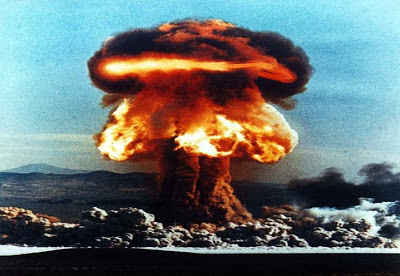
Imagine if such a war breaks out today, what would be the condition of humanity in the decades to come? Granted that unlike pre-historic times, humans now exist at all possible latitudes on the planet, it might not lead to a complete loss of development but the scientists at the cutting edge of technology, living and working in the US or Europe or China would suffer a great loss.
The people remaining behind would remember the 'supersonic planes' and 'patriot missiles' and 'submarine rocket launchers' but may not necessarily have the technology to build them! And to someone from a future generation, these technological advances would then seem like fables; stories passed down from one generation to another, just as the Pushpak Vimaan or the Divine Astras seem to us now!
One such criticism of the Vimaans is that they were said
to be drawn through the sky by “celestial steeds” (whether horses,
swans, asses, or elephants). But the answer to that lies in this sentence from a Sanskrit text called Samarangana Sutradhara which states quite unequivocally - 'Manufacturing details of these machines are withheld for the sake of secrecy, not out of ignorance!'
Probably, the
propulsion units were deliberately constructed to resemble these
animals! This particular book is an encyclopedic work on classical Indian architecture ( Vastu Shastra ) written by Raja Bhoj of Dhar
(1000-1055 AD). In 83 chapters, he covers subjects ranging from town planning,
house architecture, temple architecture, sculptural arts, painting, and a chapter on the art of
mechanical contrivances, called the YANTRAS.

The chapter on yantras is most intriguing as its verses 95-100 mention bird-shaped aerial cars ( Vimanas ), and verses 101-107 mention a sort of robots acting as guards!! It
contains 230 stanzas that are devoted to flight. It describes in
detail, every possible aspect of flying.
Sample some excerpts -
'The
aircraft which can go by its own force like a bird - on the earth or
water or through the air - is called a Vimana. That which can travel in
the sky from place to place is called a Vimana by the sage of old.'
'The
body must be strong and durable and built of a light wood [Lagha-daru],
shaped like a bird in flight with wings outstretched [mahavinhanga].
Within it must be placed the mercury engine, with its heating apparatus
made of iron underneath'.
'The iron engine must have
properly welded joints to be filled with mercury, and when the fire is
conducted to the upper parts, it develops power with the roar of a lion.
By means of the energy latent in mercury, the driving whirlwind is set
in motion, and the traveler sitting inside the Vimana may travel in the
air, to such a distance as to look like a pearl in the sky'.
Either this guy was the precursor of Jules Verne and H.G. Wells or what he wrote did make some sense even in those times! It may be that the book was not actually written by the king himself but was compiled by the experts from each discipline and given his name as a show of courtesy. Even so, the person who wrote about the aircrafts would at the least have had a very fertile imagination!!
Another popular book for the study of Vimaans is the Vyamanika/Vaimanika Shastra. It is an early 20th century Sanskrit text about the science
involved with the study, design, and manufacturing of fly-able
machines and flying them.

The text was translated in 1952 by G. R. Josyer,
according to whom it's credit goes to Pandit Subbaraya Shastry, who
dictated it in 1918-1923. It has 3000 shlokas
in 8 chapters and under the direction of Pandit Shastry, illustrations were drawn for Vaimanika Shastra by a certain T. K. Ellapa.
Illustrations based on Vaimanika Shastra
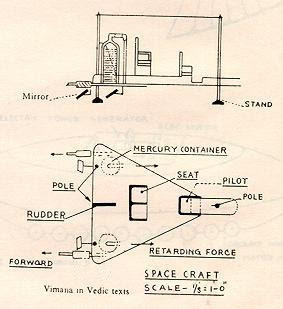
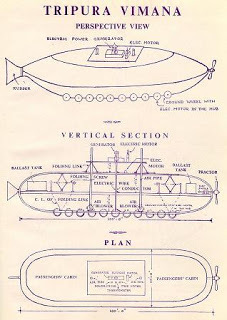
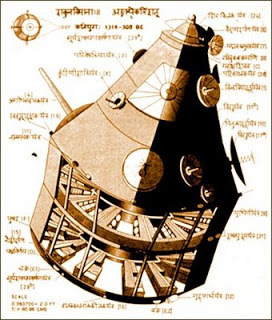
The text was then published in
Hindi in 1959 and then in 1973 into English by G.R. Josyer while
Ellappa’s illustrations were added only in the 1973 edition and were not
included in 1959 publication. Here is a list of some topics shared in the Vaimanika Shastra:
secrets for the construction of airplanes, how to avoid break them, cut them, set them on fire and destroy them;
secret to immobilize the airplane;
secret cloaking technology for the airplane;
secret to ascertain the direction of an aircraft approaching enemy;
secret of destroying enemy planes.
There are many websites and blogs dealing with this particular treatise and you can find plenty of details about the same quite easily. What you may not find is the mention of the FIRST INDIAN MAN to create an unmanned aircraft based on this book, and the recording of this event 8 years before the Wright brothers!
The man, Shivkar Bāpuji Talpade, was a friend and disciple of Pandit Subbaraya Shastry and is believed to have constructed and flown India's first unmanned airplane in the year 1895 to a height of 1500 feet based on the principles in the Vaimanika Shastra!
Talpade's airplane was named Marutsakhā, literally, 'Friend-of-the-air' and the machine flew upto a certain height before crashing down at Chowpatty. Lack of funds halted further research into the improvement of this machine by Talpade but its fateful flight was recorded by Kesari, the newspaper run by Lokmanya Bal Gangadhar Tilak in 1895!
One of Talpade’s students, P. Satwelkar, is believed to have recorded that the unmanned plane flew a few minutes and then crashed. The veracity of these claims is difficult to prove today but since the event was witnessed by none less than a Maharaja (of Baroda), the issue remains inconclusive at best.
A London Times article discussing the issue
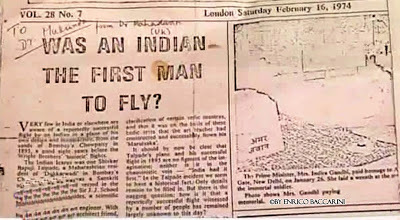
More than these relatively recent developments however, my focus is on the ancient texts such as the ones shared earlier for they corroborate what we have already discussed and reasonably concluded in an older post titled { Lokas or Planets of Advanced Aliens }.
Could the multi-limbed gods and goddesses with super-human abilities, space-crafts and atomic weaponry, actually be ALIENS with a keen interest in our world? If that were true, the existence of this technology at a time when human science was not that advanced would make sense.
Another aspect that would be covered is the mention of Maya Danav as the designer and manufacturer of these planes since the Danavs are supposed to live on the planetary system called Bila-swarga which is even more advanced than the Swarga of Indra.
Whether we consider them advanced aliens or demi-gods, these beings are
far superior to us in scientific as well as spiritual pursuits and the goal of sharing this knowledge is to follow the path of Gyaan-yoga and detach oneself from attachment to this mortal body and its entrapments.
All planets, star-systems, nebulae, galaxies, black-holes, universes, multiverse etc. are nothing but emanations from Shri Hari Vishnu. Eternity manifests itself in endless ways and Arjun got a rare glimpse of this vision in the Virat Roop of Lord Krishna
at Kurukshetra when he witnessed the entire 14 planetary
dimensions composed of numerous
Suns, Moons, Planets and Galaxies from Past, Present as well as the Future encompassed in the body of the Lord!
The Supreme Lord's Virat Swaroop

Zillions of Universes emerging from Lord Maha-Vishnu's body pores

I
conclude this post remembering the same Virat Roop of the Supreme Lord
and joining hands in supplication for deliverance from this never-ending
cycle of Birth and Death.
Isvarah paramah krishna sac-cid-anand vigrahah
anadir aaadir govindah sarva kaaran kaaranam
.
Aum Shanti: Shanti: Shanti:
.
This aerial car shining like the sun,
Moves as
one pleases, wonderful and excellent;
This Pushpak of Kuber, robbed by
Ravan in battle,
Is retained here for your
sake;
The yonder aerial car, looking like a cloud,
Stands here and by which transport,
You can reach Ayodhya without any trouble.
May prosperity attend you!
- Valmiki Ramayan [6.121.9-11]
The above verse describes the Pushpak Vimaan, perhaps the most famous airship mentioned in the ancient Hindu literature. Many Sanskrit epics contain references to such flying machines called the Vimaans/Vimanas. These Vimaans were said to be able to
travel into space between different planets and were used by various denizens of the higher Lokas. In this post, we shall analyze the evidence in favor of such flying machines being available to the ancients and their similarities to the modern aircrafts.
Vimaans in literature
There are
many descriptions of flying machines that broadly fall into two categories:
(1) Manmade aircrafts that
resemble our modern airplanes, and
(2) Alien structures that are
generally built by either the architects of Devas or Asurs and resemble the modern perception of UFOs.
The FIRST of this category are
described mainly in medieval Sanskrit literature dealing with
architecture, siege engines, and other mechanical
contrivances. Those in the SECOND category are described in ancient works such
as the Rig Veda, the Mahabharat, Ramayan, and various Puraans, and have many features reminiscent of UFOs.

We will deal with the second category first as their references are more in number, and seem to be more authentic as well. Perhaps everyone who knows anything about Hinduism, or has heard/read the Ramayan, would know about Pushpak Vimaan, the aircraft which belonged to Ravan, the king of Lanka.
Not many, however, would have heard about the architect of this aircraft - Maya Danav.
Maya, the gifted Asur conjurer

Maya was the foremost of architects among the Asurs and a formidable rival to Vishwakarma, the architect-of-the-gods. He was the father-in-law of Ravan and is credited with marvelous feats of engineering performed not only for the demons but also for Devas and humans. To list a few of these, Maya built the:
Three flying cities of Tripura for the sons of Tarkasur,
The island city of Lanka for Kuber and
the Palace-of-illusions for the Pandavs at Indraprastha.
Besides these architectural wonders, he also wrote the astronomical treatise called the 'Surya-siddhant' that forms the basis of Indian astronomy even today! Combining his knowledge of all these principles, he perhaps took the next step and created the flying vehicles or Vimaans. Maya himself, is believed to have possessed a Vimaan measuring twelve cubits in circumference, with four strong wheels.
The Pushpak Vimaan
Pushpak was originally designed for Kuber, the god-of-wealth, but was usurped by his half-brother, Ravan along with his island city of Lanka. There are various passages in the Ramayan that talk about the wonderful qualities of this aerial vehicle:
कांचनम् रथम् आस्थाय कामगम् रत्न भूषितम् |
पिशाच वदनैः युक्तम् खरैः कनक भूषणैः || ३-३५-६
मेघ प्रतिम नादेन स तेन धनद अनुजः |
राक्षसाधिपतिः श्रीमान् ययौ नद नदी पतिम् || ३-३५-७
That chariot which is decorated with golden ornaments, yoked with monster-faced mules that have gem studded trappings is ride-able by the wish of the rider, and sitting in such a chariot which is wholly golden and which rides with a sound like the pealing of thunder, that celebrated Ravan, the brother of Kuber and the lord of demons, traveled towards the lord of rivers and rivulets, namely the ocean.
So, the Pushpak was an aerial vehicle, navigable by thought, shimmering like the Sun, with a thunderous noise and could travel anywhere across the globe. Sounds like a cross between a UFO and one of our modern supersonic planes!
An alleged UFO sighting in Mexico

The special characteristic of this vehicle seems to be that whatever may be the number of people sitting inside the plane, there would always be one seat vacant! In other words, if N number of people want to board the plane, there would still be (N+1) seats available. This prodigious capacity is mentioned to in the following verses:
प्रियाअत्प्रियतरं लब्धं यदहं ससुहृज्जनः || ६-१२२-२२
सर्वैर्भवद्भिः सहितः प्रीतिं लप्स्ये पुरीं गतः |
Shri Raam said - Something more dearer than everything dear will be achieved by me, if I reach Ayodhya with the host of my friends along with all of you, for, I shall feel delighted.
This is when Vibhishan, the brother of Ravan and the newly crowned king of Lanka tells the Lord, that the aircraft can carry as many people as the Lord would want to accomodate!
ततह् स पुष्पकं दिव्यं सुग्रीवः सह वानरैः || ६-१२२-२४
आरुरोह मुदा युक्तः समात्यश्च विभीषणः |
Thereupon, that Sugreeva along with the monkeys gladly ascended that wonderful Pushpaka, the aerial car. Vibhishan together with his counselors also ascended it.
तेष्वारूढेषु सर्वेषु कौबेरम् परमासनम् || ६-१२२-२५
राघवेणाभ्यनुज्ञातमुत्पपात विहायसम् |
When all of them ascended, that excellent aerial car, belonging to Kuber, flew into the sky, after having been duly authorized by Rama.
Pushpak Vimaan - Pahari miniature painting

खगतेन मिवानेन हंसयुक्तेन भास्वता || ६-१२२-२६
प्रहृष्टश्चप्रतीतश्च बभौ रामः कुबेरवत् |
Feeling greatly rejoiced and satisfied while travelling in that splendid aerial car, which was now in the air and was provided with the image of a swan, Rama shone like Kuber.
ते सर्वे वानरर्क्षश्च राक्षसाश्च महाबलाः || ६-१२२-२७
यथासुखमसंबाधं दिव्ये तस्मिन्नुपाविशन् |
All those mighty Vanars, bears and demons sat comfortably and spaciously in that wonderful aerial car.
Another such description is found in the Ayodhya Kand [XVI, pp. 235-236]-
The splendid chariot, made of silver, and bright like the fire itself, making a noise like the roaring of the clouds; defying all obstacles, adorned with jewels and gold, dazzling to the eyesight and bright, went speedily on, making space resound like unto the muttering cloud in the sky. He issued out of his abode like the beautiful moon passing through a huge cloud.
As mentioned in the post { Rama - The Historical Perspective }, in Sri Lanka, the Pushpak Viman is referred to as the Dhandu Monara or the Flying-Peacock and even today there exists a place called Weragantota in Lanka whose name implies 'The-Landing-Place-of-Aircraft'!! Not far from there is another place called Gurulupotha (parts-of-birds) where he is supposed to have the aircraft-repair center!
One of the 6 airports of Ravan - Weragantota


This implies that it is more than likely that the Pushpak Vimaan DID actually exist and was perhaps the last aircraft of its kind before the advent of our so called modern age.
Other References to Vimaans
The Pushpak is not the only aircraft mentioned in so much detail. The Mahabharat mentions such celestial crafts in many passages as well!
During his quest for celestial weapons before the Mahabharat War, Arjun was invited by Indra to spend some time in Amravati. Indra's charioteer Matali came to pick him up and this is how the description goes:
And on this sunlike, divine, wonderful chariot the wise disciple of Kuru flew joyously upward. When becoming invisible to the mortals who walk the earth, he saw wondrous airborne chariots by the thousands.
And the celebrated Arjun, having passed through successive regions of the heavens, at last beheld the city of Indra. And there he beheld celestial cars by thousands stationed in their respective places and capable of going everywhere at will, and he saw tens of thousands of such cars moving in every direction!
- Mahabharat Indralokgamana Parv
While in heaven, Arjun helped Indra curb the Asur menace and assisted his father in a few battles:
When the Daityas were being slaughtered they again took to their vimana and, employing the Danava science, flew up into the sky . . . I (Arjuna) assaulted their vimana . . . Wounded by the flight of deadly-accurate iron missiles, the Asura vimana fell broken to the earth . . . Matali swiftly descended earthward, as in a steep dive, on our divinely effulgent car.
Deva-Asur celestial war

Again, in the Swargaohan Parv, when Indra's spacecraft comes to pick up Yudhhishthir, this is the description given:
Then Dharma and Indra and the other
deities, causing Yudhishthira to ascend on a car, went to the celestial
region. Those beings capable of going
everywhere at will, rode their respective aerial cars. King Yudhishthira,
riding on his car, ascended quickly, causing the entire sky to blaze
with his effulgence.
If these passages do not talk about aircrafts or space-ships, what do else do they refer to??
Further support for the Vimaans comes from the Puraans like Shrimad Bhagvat Puraan.
There is an entire battle that rages at the port city of Dwarka which
is caused by a disgruntled king called Salva and his out-of-the-world
airplane:
Lord Siva said, "So be it." On his order, Maya Danava, who conquers his enemies' cities, constructed a flying iron city named Saubha and presented it to Salva.
[SB 10.76.7]
This
unassailable vehicle was filled with darkness and could go anywhere.
Upon obtaining it, Salva went to Dvaraka, remembering the Vrishnis'
enmity toward him.
[SB 10.76.8]
At
one moment the magic airship built by Maya appeared in many identical
forms, and the next moment it was again only one. Sometimes it was
visible, and sometimes not. Thus Salva's opponents could never be sure
where it was.
[SB 10.76.21]
From one moment to the next the Saubha airship
appeared on the earth, in the sky, on a mountain peak or in the water.
Like a whirling, flaming baton, it never remained in any one place.
[SB 10.76.22]
There are other such passages too concerning other characters from the Puranic history:
Having spoken thus, Maharaja Nriga circumambulated Lord Krishna and touched his crown to the Lord's feet. Granted permission to depart, King Nriga then boarded a wonderful celestial airplane as all the people present looked on.
[SB 10.64.30]
As soon as the symptoms of his liberation were manifest, he saw a very
beautiful airplane coming down from the sky, as if the brilliant full
moon were coming down, illuminating all the ten directions.
[SB 4.12.19]
A spacecraft Out-of-this World

Dear King Dhruv,
neither your forefathers nor anyone else before you ever achieved such a
transcendental planet. The planet known as Vishnuloka, where Lord Vishnu
personally resides, is the highest of all. It is worshipable by the
inhabitants of all other planets within the universe. Please come with
us and live there eternally.
[SB 4.12.26]
O immortal one, this unique airplane has been sent by the Supreme
Personality of Godhead, who is worshiped by selected prayers and who is
the chief of all living entities. You are quite worthy to board such a
plane.
[SB 4.12.27]
It may be difficult for us to believe that such technology existed in those ancient times because we have been conditioned to believe that modern time is the 'Golden age of science'. But, what if our ancients were more advanced than us??
Were the ancients more advanced?
The natural question that comes up is that if this were so, where did all that technology vanish? My guess would be that the Mahabharat War was NUCLEAR in nature and the use of all those divine Astras (aka Nuclear weapons) led to the decimation of not only a large portion of the world population but also the technology and civilizational progress that mankind had achieved till then.

Imagine if such a war breaks out today, what would be the condition of humanity in the decades to come? Granted that unlike pre-historic times, humans now exist at all possible latitudes on the planet, it might not lead to a complete loss of development but the scientists at the cutting edge of technology, living and working in the US or Europe or China would suffer a great loss.
The people remaining behind would remember the 'supersonic planes' and 'patriot missiles' and 'submarine rocket launchers' but may not necessarily have the technology to build them! And to someone from a future generation, these technological advances would then seem like fables; stories passed down from one generation to another, just as the Pushpak Vimaan or the Divine Astras seem to us now!
One such criticism of the Vimaans is that they were said
to be drawn through the sky by “celestial steeds” (whether horses,
swans, asses, or elephants). But the answer to that lies in this sentence from a Sanskrit text called Samarangana Sutradhara which states quite unequivocally - 'Manufacturing details of these machines are withheld for the sake of secrecy, not out of ignorance!'
Probably, the
propulsion units were deliberately constructed to resemble these
animals! This particular book is an encyclopedic work on classical Indian architecture ( Vastu Shastra ) written by Raja Bhoj of Dhar
(1000-1055 AD). In 83 chapters, he covers subjects ranging from town planning,
house architecture, temple architecture, sculptural arts, painting, and a chapter on the art of
mechanical contrivances, called the YANTRAS.

The chapter on yantras is most intriguing as its verses 95-100 mention bird-shaped aerial cars ( Vimanas ), and verses 101-107 mention a sort of robots acting as guards!! It
contains 230 stanzas that are devoted to flight. It describes in
detail, every possible aspect of flying.
Sample some excerpts -
'The
aircraft which can go by its own force like a bird - on the earth or
water or through the air - is called a Vimana. That which can travel in
the sky from place to place is called a Vimana by the sage of old.'
'The
body must be strong and durable and built of a light wood [Lagha-daru],
shaped like a bird in flight with wings outstretched [mahavinhanga].
Within it must be placed the mercury engine, with its heating apparatus
made of iron underneath'.
'The iron engine must have
properly welded joints to be filled with mercury, and when the fire is
conducted to the upper parts, it develops power with the roar of a lion.
By means of the energy latent in mercury, the driving whirlwind is set
in motion, and the traveler sitting inside the Vimana may travel in the
air, to such a distance as to look like a pearl in the sky'.
Either this guy was the precursor of Jules Verne and H.G. Wells or what he wrote did make some sense even in those times! It may be that the book was not actually written by the king himself but was compiled by the experts from each discipline and given his name as a show of courtesy. Even so, the person who wrote about the aircrafts would at the least have had a very fertile imagination!!
Another popular book for the study of Vimaans is the Vyamanika/Vaimanika Shastra. It is an early 20th century Sanskrit text about the science
involved with the study, design, and manufacturing of fly-able
machines and flying them.

The text was translated in 1952 by G. R. Josyer,
according to whom it's credit goes to Pandit Subbaraya Shastry, who
dictated it in 1918-1923. It has 3000 shlokas
in 8 chapters and under the direction of Pandit Shastry, illustrations were drawn for Vaimanika Shastra by a certain T. K. Ellapa.
Illustrations based on Vaimanika Shastra



The text was then published in
Hindi in 1959 and then in 1973 into English by G.R. Josyer while
Ellappa’s illustrations were added only in the 1973 edition and were not
included in 1959 publication. Here is a list of some topics shared in the Vaimanika Shastra:
secrets for the construction of airplanes, how to avoid break them, cut them, set them on fire and destroy them;
secret to immobilize the airplane;
secret cloaking technology for the airplane;
secret to ascertain the direction of an aircraft approaching enemy;
secret of destroying enemy planes.
There are many websites and blogs dealing with this particular treatise and you can find plenty of details about the same quite easily. What you may not find is the mention of the FIRST INDIAN MAN to create an unmanned aircraft based on this book, and the recording of this event 8 years before the Wright brothers!
The man, Shivkar Bāpuji Talpade, was a friend and disciple of Pandit Subbaraya Shastry and is believed to have constructed and flown India's first unmanned airplane in the year 1895 to a height of 1500 feet based on the principles in the Vaimanika Shastra!
Talpade's airplane was named Marutsakhā, literally, 'Friend-of-the-air' and the machine flew upto a certain height before crashing down at Chowpatty. Lack of funds halted further research into the improvement of this machine by Talpade but its fateful flight was recorded by Kesari, the newspaper run by Lokmanya Bal Gangadhar Tilak in 1895!
One of Talpade’s students, P. Satwelkar, is believed to have recorded that the unmanned plane flew a few minutes and then crashed. The veracity of these claims is difficult to prove today but since the event was witnessed by none less than a Maharaja (of Baroda), the issue remains inconclusive at best.
A London Times article discussing the issue

More than these relatively recent developments however, my focus is on the ancient texts such as the ones shared earlier for they corroborate what we have already discussed and reasonably concluded in an older post titled { Lokas or Planets of Advanced Aliens }.
Could the multi-limbed gods and goddesses with super-human abilities, space-crafts and atomic weaponry, actually be ALIENS with a keen interest in our world? If that were true, the existence of this technology at a time when human science was not that advanced would make sense.
Another aspect that would be covered is the mention of Maya Danav as the designer and manufacturer of these planes since the Danavs are supposed to live on the planetary system called Bila-swarga which is even more advanced than the Swarga of Indra.
Whether we consider them advanced aliens or demi-gods, these beings are
far superior to us in scientific as well as spiritual pursuits and the goal of sharing this knowledge is to follow the path of Gyaan-yoga and detach oneself from attachment to this mortal body and its entrapments.
All planets, star-systems, nebulae, galaxies, black-holes, universes, multiverse etc. are nothing but emanations from Shri Hari Vishnu. Eternity manifests itself in endless ways and Arjun got a rare glimpse of this vision in the Virat Roop of Lord Krishna
at Kurukshetra when he witnessed the entire 14 planetary
dimensions composed of numerous
Suns, Moons, Planets and Galaxies from Past, Present as well as the Future encompassed in the body of the Lord!
The Supreme Lord's Virat Swaroop

Zillions of Universes emerging from Lord Maha-Vishnu's body pores

I
conclude this post remembering the same Virat Roop of the Supreme Lord
and joining hands in supplication for deliverance from this never-ending
cycle of Birth and Death.
Isvarah paramah krishna sac-cid-anand vigrahah
anadir aaadir govindah sarva kaaran kaaranam
.
Aum Shanti: Shanti: Shanti:
.
Published on June 01, 2013 09:50
March 7, 2013
The Dance of Shiva
Om tryambakaṃ yajāmahe sugandhiṃ puṣṭi-vardhanam
urvārukam iva bandhanān mṛtyormukṣīya māmṛtāt
The above verse from Rigveda [7.59.12], known as the Mahamritunjaya or the Death-conquering Mantra is dedicated to Lord Shiva. Ironically, it is Shiva Himself who is revered as the harbinger of the final Destruction of the World!
Who is Shiva? What are the origins of this mighty god in Hindu religion
and what are the different facets of His personality? In this post, let
us try to analyze this enigmatic god and learn what it means to be the
Lord of Destruction..
Shiva, the Destroyer
As mentioned in the Page { 33 Devas } of this blog, Lord Shiv, along with Prajapati Brahma and Shri Hari Vishnu, forms a part of
the highest echelons of the hierarchy amongst Gods known as the Trimurti . All three fit into the scheme of things perfectly with their respective roles being coplimentary to each other.
Brahma , the First in the Trinity, is the Creator and Master of all Divine Ceremonies.
Vishnu , the
Preserver god who incarnates to help mankind face the challenges posed
whenever Evil forces become too dominant in the Universe.
Shiva , destroys at the End of Time and thus sustains the endless rhythm of the Universe ensuring a continuous cycle of renewal and growth.
Mahadev-Shiv-Pashupati-Rudra

In their mistaken belief, some scholars argue that Shiva had a pre-Aryan
origin because he was worshiped in the Indus Valley. But, as mentioned
in the page { Hindu History }
of the blog, the Aryan Civilization, if not earlier, was
at the very least contemporary to the Indus-Saraswati Civilization and Vedic scriptures, more likely than not, reflect the literally aspect of the same.
That the Mahabharat follows
the Indus perception of Shiva again shows that the two developed same imagery and that this
penultimate battle between Good and Evil occurred around the same time
as the Indus-Saraswati Civilization! In an article titled { The Riddle of India's Ancient Past }, the French proto-historian Michel Danino believes there are strong links between Vedas and the Harappan culture.
'We
find statues and seals depicting yogis and yogic postures, we find a
Shiva-like deity, worship of a mother-goddess, fire altars, all of which
are suggestive of Vedic culture. Harappan symbols include the Trishul, the Swastika, the Conch shell, the Peepal tree,
all of which are central to Indian culture. The Rig-Veda itself
is full of references to fortified cities and towns, to oceans, sailing,
trade and industry, all of which are found in the Harappan
civilization.'
Pashupati Seal from Indus-Saraswati excavations
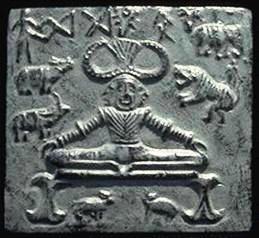
The Pashupati seal (2700 BCE) shows a three-headed figure sitting in a Yogic posture surrounded by animals, sometimes with an erect phallus, and more likely than not is an iconic representation of Shiva-Rudra. Exactly similar description arises in the Mahabharat, where the Lord is referred to as
Trishira (having three
heads); Digvasas (without clothes); Urddh-linga (with upward erect phallus),
and Yogadhyaksha , or the Lord of Yoga.
As you probably know from my other posts, I love to find out the similarities between the mythologies from different parts of the world. Keeping up with the tradition, I here share with you the image of the horned god Cernunnos worshiped in Europe around 1st century CE.
The Horned Gods - Pashupati & Cernunnos
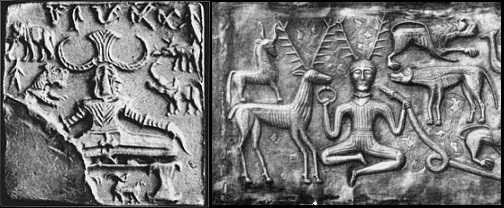
Just like Shiva, Cernunnos is believed to be the god of Nature and Fertililty and is still revered in Celtic mythology as the 'Lord of Animals' (quite similar to the Indus Pashupati !). Whatever the connection between the two, it is not easy to understand Shiva completely as He is described variously at various places with completely opposite attributes.
In Yajurveda , the contrary attributes are referred to as Rudra, the terrifying and Shiva, the auspicious (Sanskrit Shiv = Shubh ). Some scholars believe Rudra to be the older form which was merged later with a 'Non-Aryan' god Shiva or Pashupati in later times. But do the
scriptures support such a hypothesis?
Shiva, the Consummate Yogi
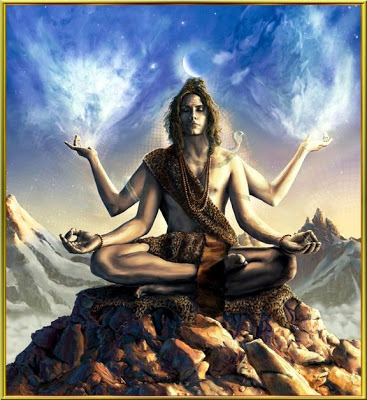
Rudra, the Destroyer of Creation

{Image courtesy - Devon ke dev, Mahadev}
Shiva or Rudra?
The story of Rudra's birth is very interesting and is identically revealed in many Puranas.
As I had earlier mentioned in the post { Creation by Brahma }, inspite of Brahma's efforts at populating the world, the early sons of Brahma chose to follow the path of
Spirituality instead of
procreation and Brahma was sorely disappointed. His first creations, the Sanat Kumars, in fact abhorred entering the Samsar Chakra so much that they continue living the form of 5 year old kids and never attain puberty!
This, however,
frustrated Brahma so much that from his forehead, (the region of the
third eye) emerged a dark red/blue child bawling at the top of his
voice. This angry baby was named Rudra (The Howler)!
Rudra born from Brahma's Frown

However, Rudra, was more spiritually inclined than Brahma, and decided to follow the path of Tapas
or Penance and thus entered samadhi in the Garbhodak Ocean . It was only after a lot of cajoling and praying
by Brahma, that He agreed to help in procreation and manifested 10 more beings with the
same appearance as him (Binary Fission?!?). These are the 11
Rudras, and Rig Veda [2.33], describes Shiv as the Father-of-All-Rudras.
Thus,
we see, that the scriptures find NO difference between Rudra and Shiva except that the
first term encompasses eleven gods, the First and Foremost of whom is
Lord Shiv. Therefore, the hypothesis that Shiva was a non-Aryan god who was merged with Rudra is baseless.
Lord Shiv with the Rudras

As regards the three-eyes, it is interesting to note that the Pineal gland in Human beings is located at the region of the Third-Eye and has tissue similar to that of the normal functioning eye. Indeed the gland in many vertebrates has cells similar to the photoreceptors of eye used for vision! Could it then be another vestigial organ that we humans possessed earlier but now has a very limited value??
The Deep Seated Third Eye
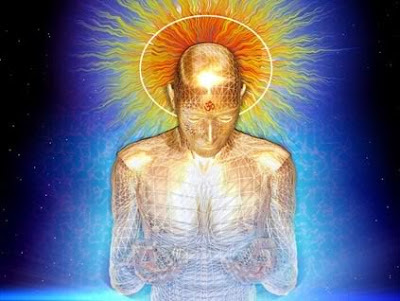
Shiva, the only being with a Completely functional Pineal Gland?
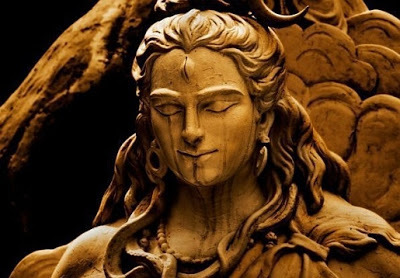
Lord Shiv, then would be the most ancient progenitor of our race in whom the organ functions as it should. But Brahma got terrified of these three-eyed fierce forms and requested Lord Shiva to create a more benign aspect of Himself and that is how Shakti was given a form!
Shiva and Shakti
Rudra, thus took the form of Ardhanarishwar and generated a female principle from His left half who was the Rudrani . Each of the 11 Rudras similarly obtained a consort thus providing Brahma some satisfaction of
seeing his creations multiply. Shiva's consort Uma or Shakti is the primeval Goddess who also represents the Yogmaya of Lord Vishnu.
Lord as Ardha-naarishwar

The festival of Mahashivaratri marks the night when Lord Shiv was married to Parvati, the final form of Uma who was earlier born as Daksha's daughter Sati .
Shiva with His beloved Sati in happier times
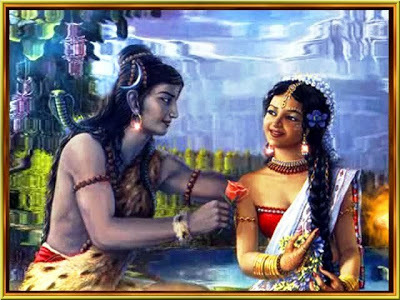
The union of Shiva and Shakti is represented symbolically in the form of the Lingam and the Yoni . It symbolizes Hieros-gamos or
the 'Sacred Union' between God and the Goddess that gives birth to
creation. It is yet another tribute to the ancient Indians' acceptance
of the sexual act as a natural phenomenon and one that needs to be
worshiped and not abhorred.
The same union is celebrated in Tibetan Tantrism where it is referred to as Yab-Yum (Father-Mother). Shiva is depicted here as Yamantaka or End-of-Yama revealing the episode when He rescued Rishi Markandeya from Yamdev's noose literally at gun-point (Trident point if you please!).
Yamantaka Shiva in Yab-Yum formation

While both Shiva and Shakti represent the Male and Female forms, their vehicles also represent their innate attributes. Shiva's vehicle Nandi, the bull, represents magnificence, virility and proud masculinity while Parvati's vehicle, the mountain Lion or Singh represents her Power or Shakti and the taming of animal instincts by the Mother Goddess.
Archaeologically, we find this reflected in the Zebu bull seals of Indus-Saraswati Civilization (which may represent Nandi ) and surprise, surprise, in a far-off valley in Turkey known as Yazili Kaya! The rock-cut friezes in these caves belong to 16th-17th century BCE and show a God Teshav riding a bull, while the accompanying Goddess Hakat rides a Lion and is accompanied by a young boy Kumarbi (Kumar Kartikeya?).
Zebu Bull from Harrapan seals
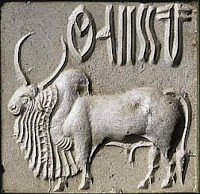
Yazili Kaya rock-cut frieze with God on Bull and Goddess on Lion
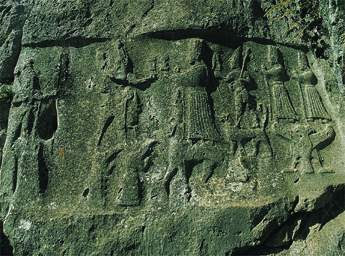
The worship of Shiva and Shakti thus represents an ancient rite of recognizing the Universe as a balance of the Male and the Female, the Doer and the Energy, the Yin and the Yang and the Yab and the Yum. The night of their union or Mahashivratri is also believed to be the night when Shiva appeared in the form of a Lingam of Fire and challenged the gods Brahma and Vishnu's contest for supremacy. That was the night Lord Vishnu's magnanimity came to fore while Brahma's cheating led to Shiva putting the curse that he would never be worshiped. The Somnath Temple in Gujarat commemorates this very occasion!
My visit to the Somnath Temple
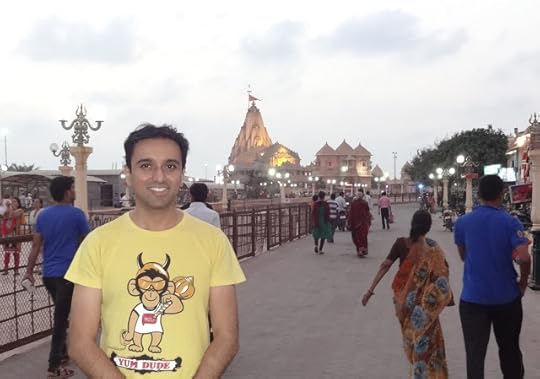
We see now a reason why Shiva would have invoked belligerence in his father-in-law Daksha Prajapati. After all, Daksha was the eldest Manas-putra of Brahma and could not have taken kindly to this denigration of his father's position from the Head-of-the-Trinity to its bottom! Perhaps, that was also the reason, that he balked at the idea of his most favored daughter Sati, falling in love with the man he so heartily despised!!
Sati did eventually marry Lord Shiv against her father's wishes and ultimately sacrificed herself in the Yagnya fire at Kankhal, Haridwar
to protect her husband's honor. Shiva carries the corpse of Sati on His shoulder lamenting His loss till Lord Vishnu uses His Chakra to disintegrate the body. Each part of the body falling on Earth provides a Divine foundation and thus are formed the 51 Shaktipeeths (Seats-of-Energy)!
This incident shows that Shiva and Vishnu work in tandem too and their Oneness-in-Duality is also seen in the combined form of Vishnu (Hari) and Shiva (Har) that depicts both deities as two faces of the same coin working hand-in-hand to ensure smooth functioning of the Universe.
Hari-Hara the Divine combination of Lord Vishnu and Lord Shiva
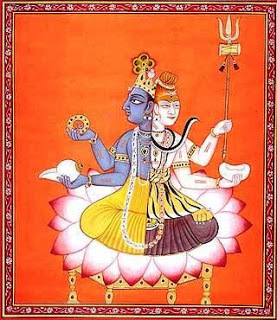
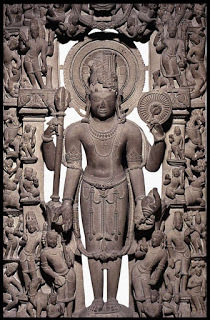
The story shows a completely new side
of Shiva where the Supreme Master-of-Senses loses control and decides to
take revenge by beheading Daksha!
Virbhadra , born from Shiva's locks beheads Daksha

Virbhadra statue carved out of rock at Kailash Temple, Ellora

This is what makes Shiva more relatable to humans.. it shows that even
at the highest level of spirituality, the bonds of affection may cause a
person to slip and plunge into gloom or anger.
Kailash, the Abode of Shiva
Talking about Kailash, the holy mountain is believed to be the abode of Shiv and Parvati. There are many mentions of it in the various Puranas and other scriptures like Ramayan and Mahabharat. The mountain is sacred for not only Hindus but also Buddhists, Jains and followers of Bon religion.
Satellite Image of Mt. Kailash with Mansarovar and Rakshas Taal
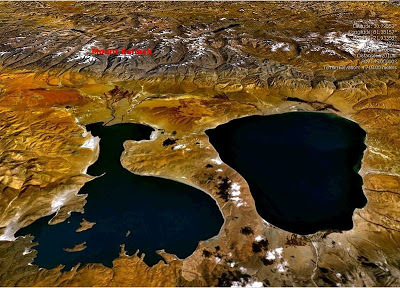
Catching a glimpse of the Holy Mountain
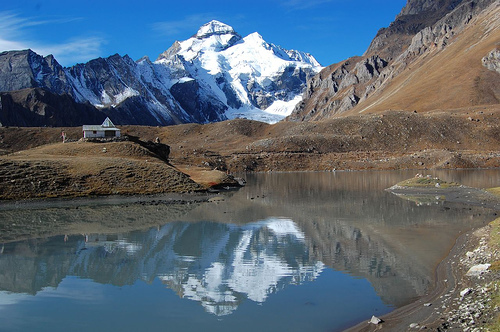
Jains worship the region as their First Tirthankar, Rishabhdev attained Nirvana here (Check the post { India and Bharat } for more on Adinath Rishabhdev). Tibetan Buddhists worship Mount Kailash as the home of the Buddha Demchok or Chakrasamvara , who represents supreme bliss.
The followers of Bön religion credit the entire region, especially Kailash, as the seat of all spiritual power. Indeed the area gives one a feeling of entering a more spiritual plane especially when you see mountain peaks like that of the Om Parvat.
View of the Om Parvat en route to Mount Kailash
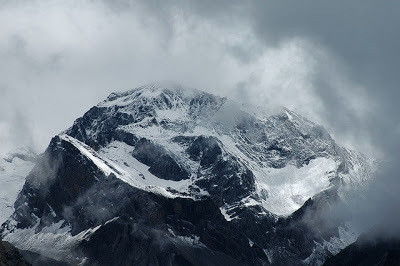
Inspite of numerous references to it, the readers might be surprised to know, that Kailash was not always the home of Shiva! Infact, some passages of the Shrimad Bhagvat Puraan state that the original abode of Sadashiv is at the boundary of this Universe at the Loka-aloka border!
The Original Abode of Lord Shiv

These verses in the Vayu Puraan, Chapter 39 shed more light on the details of this place:
[230]
Beyond Brahmaloka and beneath the upper crust of the Cosmic Egg – in
between these two is Shiva’s city, his divine abode called MANOMAYA.
[238] The city shines with scattered diamond dust. These
worlds are lit from within, meaning their reality does not consist of
reflected light, as does our material world.
[264-266]
Lord Maheshwar [the transcendent Lord Shiv] of ten arms sports therein… He is respected and diligently worshiped by the people moving about in
aerial chariots.
This, then is the Original and Supreme abode of Shiva where He resides till the end of Creation and is visited by the other gods in their space-crafts {Check the post Lokas or Alien Planets for more on this topic}. Kailash may actually be the temporary home where the Lord comes for a small time, maybe as a summer-retreat!
Shiva Family on Mount Kailash

This would also make sense, since geologically, the Himalayas (of
which Mount Kailash is a part), did not rise up till about 5o million
years ago!
Since Hindu Timelines begin close to 155 Trillion years (the present age of Brahma), hence, obviously Lord Shiv would have had to live somewhere else before finally making Kailash His home!! Also, the Himalayas wont stay forever as the Pralaya or the End-of-the-World would destroy the World as we know it and Brahma would then remould it into a new shape.
At that time, Shiva would probably return to the abode known as Manomaya with His family and Kailash may or may not come into being again.
Naimittik Pralaya
The
destruction that takes place at the end of a daytime of Brahma is
referred to as Naimittik , implying incidental or occasional opposed to Prakritik Pralaya that takes place at the end of Brahma's lifetime. {Check the post - Pralaya, the End of Days for more on this}
The
characteristic of this destruction is that the three worlds (Bhur, Bhuvah and Swarga) continue to
exist but are made uninhabitable. The souls of individuals also
continue to exist to be reincarnated in the next daytime of Brahma.
The Shiv Purana [2.3.20.14-19]
states that the fall off of the energy residing in the THIRD EYE of
Shiva fell like lightning and Brahma had to take it to the ocean and
keep it under check there else it could burn the entire creation!
The energy thus released was stored underwater in the shape of a mare and is known as the Vadava {Check this link for details - On Wings of Fire }. The
fire-mare resides under the ocean (Molten Earth's core?)
and one of the myths calls her wife of Yama and hence a
harbinger of Death.
Vadava Fire hidden below the Oceans
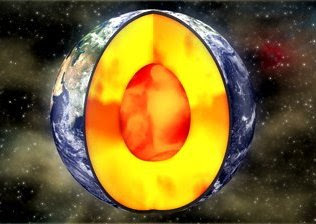
Swayambhu
Manu alludes to this fire from Shiva's eye stating that in two cases Fire
is born out of Water. One, at the time of Lightening and secondly, in
the case of the under-water Vadava Mare. Brihadaranyak Upanishad [1.1.2] states that the open mouth of this mare keeps releasing fire in
the Sea from time to time, perhaps alluding to submarine eruptions common in
the ocean floor!
Submarine Volcanoes - Flames of the Vadava Fire?
Eruption of an Underwater Volcano
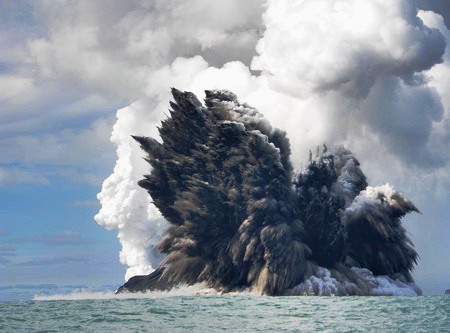
Normally, the fire is kept in check with the waters of the Global Ocean. But as Mahabharat
verses [12.248.13-17] state, the end of the Day of Brahma is nigh that
Rudra sparks off the fire again and this explosion from the
mare's mouth in the Southern Ocean begins the process of Pralaya.
Vishnu Purana [1.7.24-40] also agrees that this
destruction would begin with an underwater explosion that will take place in the Southern Ocean. It will be succeeded by a 100 year drought during which the seas, rivers, and streams will all be drained of water. The sun is replaced by seven suns (Sun will increase in size?), and the three world as well as the underworlds are burned bare of life.
This then, is the Final Destiny of our planet and this is what we call Tandav, the Final Dance of Shiva. As each atom is created, another is destroyed and this continues forever in a cyclical manner. Lord Shiv who drinks the terrible poison Halahal to save all Life, also destroys Life-as-we-know-it in the form of Rudra.
Shiva drinks poison to save Life yet also annihilates at the End of Time

I conclude this post with the invocation I started the post with as there is nothing better to pray for except getting out of this Samsara Chakra. This Mahashivratri, let us remember the Lord with our hearts and minds and pray for deliverance:
Om tryambakaṃ yajāmahe sugandhiṃ puṣṭi-vardhanamurvārukam iva bandhanān mṛtyormukṣīya māmṛtāt
OM, We worship Shiva, the Three-eyed fragrant Lord,
Who nourishes and nurtures all beings,
As is the ripened cucumber freed from its bondage (to the creeper),
May He liberate us from Death and take us to Immortality.
Aum Shanti: Shanti: Shanti:
Published on March 07, 2013 10:53
January 11, 2013
Seventh Horse of the Sun
Suraj ka saatvaan ghoda..
Still remember this title from an obscure movie I had watched on Doordarshan as a kid. The movie by Shyam Benegal went on to become a classic and the phrase stayed put in some corner of my mind.. What could it have meant, the '7th Horse of the Sun'?? For that matter, why have seven horses in the first place?
In Hindu mythology, Surya travels through the sky on a seven-horse, twelve-spoked chariot, driven by Arun (the brother of Garud), with its arrival heralded by Usha, As the Sun begins its apparent journey towards the Northern Hemisphere (Uttarayan) again, lets try to decode the mysteries of Surya and his chariot in the current post.
Surya on his chariot
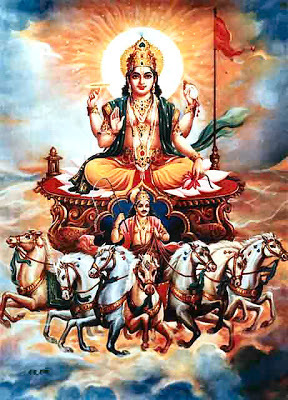
A lot of people might think that this motion of the Sun mentioned in the scriptures refers to the apparent movement of Sun from East to West, but that's not the case. Scriptures clearly mention that the Sun revolves NOT around the Earth but around Mount Meru!
If you check the post {Heaven at the North Pole} you will understand what it means.. Mount Meru points towards the Pole Star which, at the time scriptures were written, was a Star near the Galactic Center so effectively, scriptures indicate that our Sun revolves around the Galactic Center and NOT the Earth.. What an amazing insight!!
Uttarayan reflects the apparent movement of the Sun towards the Northern Hemisphere heralding the decline of winter while causing the opposite effect in the Southern Hemisphere. Earth revolves around the Sun with a tilt of 23.45 degrees and because of this tilt, it
appears that the Sun travels north and south of the equator.
Sankrant reflects the change of Season
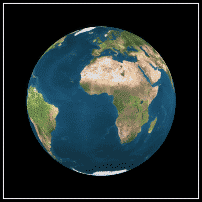

This in turn causes seasons which are thus dependent on equinoxes and solstices and the festival of Makar Sankranti heralds the onset of a glorious Sun and end of the harsh winters. In many parts of the country, it is also harvest time so the celebrations take form of the regional variants like Lohri, Bihu and Pongal.
Adityas - The 12 Solar gods
Oldest Vedic texts describe
Surya alongwith 11 other brothers collectively known as the Adityas. Adityas form a group of solar deities and are so named because they are the sons of Kashyap and Aditi. They form the main body of the Hindu pantheon and are comprised of:
Ansh (Due share),
Aryaman (Nobility),
Bhaag (Due inheritance),
Daksh (Ritual skill),
Dhatri/Tvashtar (Skill in crafting),
Mitra (Friendship),
Pushan/Ravi (Prosperity),
Savitra/Parjanya (Power of word),
Surya/Vivasvan (Social law),
Varun (Cosmic fate),
Vaman (Cosmic law).
Earliest scriptures actually mention 8 or 9 of them
but later in the Brahmanas the number is given as 12. It isn't difficult to understand that the 12 Adityas correspond to 12
months of the year!
According to
Lokmanya Bal Gangadhar Tilak's masterpiece called {Arctic Home of the Vedas},
the change in their number reflects the gradual migration of Arya rishis from near the Pole
to the tropics after the Ice Age! As they migrated closer to the tropics, the number of months when Sun was up kept on increasing till they reached the Indian sub-continent.
Interestingly, in Chinese mythology as well, there were originally ten suns in the sky, who were
brothers and were supposed to emerge one at a time as commanded by the
Jade Emperor. The 12 Adityas were also adopted into Japanese Buddhism as guardians of the monasteries covering the
four main directions, four semi-directions, above, below and the Sun
and Moon. They are known as Devas or Ten 天 in Japan (which literally
means Heaven or Celestial).
The 12 Japanese Adityas

A similar depiction is found on a rock-cut cave far away in Yazili Kaya
in Turkey! This rock-cave has multiple depictions of Gods and Goddesses
that resemble Hindu gods. The lower chamber in this cave shows a frieze
with 12 gods carved onto it who were worshiped by the people known as Hittites.
The 12 Adityas from Turkey
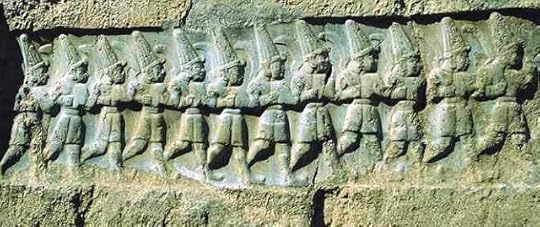
Moving westwards, it is also worthwhile to note that in most Indo-European religions, the gods worshiped were more or
less the same. Thus, the Greeks called their Sun-god Helios while others named him Apollo.
The Greek Sun-god Helios/Apollo

For the Romans, the cult of Sol Invictus
or 'Undefeated Sun' was supreme. Roman Emperor Constantine adhered to it so much that
even when he embraced Christianity, he changed the day of Sabbath from Friday
to SUN-day!!
Sol Invictus
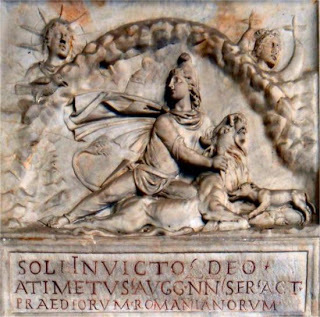
During the heyday of the Roman Empire, there was also a grand festival of the birth of the Unconquered Sun (Dies Natalis Solis Invicti) held on the Winter solstice on December 25th. This was a sort of 'Rebirth of the Sun' and the same date was later transferred to the 'Birth of Christ' even though Jesus was actually born on the 4th of January!!
The worship of Surya was prevalent in other ancient civilizations of the world as well. Mayans (who scared the World with their 2012 Doomsday prophecy) called him Hunahpu. The Aztecs named him Tonatiuh, Japanese revered him as Chupkamui, and the Babylonians called him Aja.
The Egyptians worshiped Sun in the form of Re/Ra. In Egyptian myths of the afterlife, Ra rides in an underground channel
from west to east every night so that he can rise in the east the next
morning.
Egyptian Sun-god Re
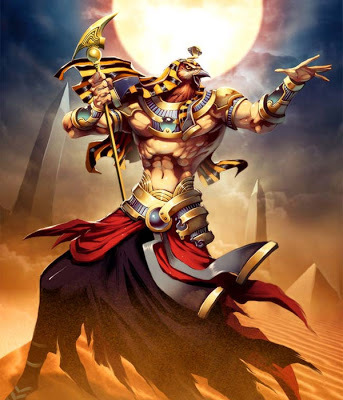
In Vedas, Surya is considered in high esteem and is referred to as Surya Narayan and at various times, as the eye of Mitra or
Varuna, the cosmic law-keepers. The same is reflected in Zoroastrianism where the Sun is described as the 'Eye of Ahura'.
In India of course different dynasties trace their
lineages from the Sun with Shri Raam as a descendant of Surya, thus belonging to the Suryavansh or the Solar Dynasty. The Ramayan also declares Surya as the father of the Vanar King Sugriv just as the Mahabharat describes Karna, as the son of Kunti and Surya. Perhaps, amongst the Aryans, the blonde, blue-eyed lineages migrating from the Steppes represented the Descendants-of-the-Golden-Sun!
Hindu Sun-god Surya

Surya has two wives Sangya and Chhaya (literally the shadow) and through them has the folowing children: Shani (Saturn), Yamraj (Lord-of-Death), Yamuna, Tapti, Ashwini Twins and the eldest of these Vaivasvat Manu, the First Man in the current Age or Manvantar. {For more on the First Man Manu/Adam check the following post - Manu, the First Man}
However, this is NOT TO SAY that the ancient Indians thought of the Star called SUN as a demigod and did not understand its true significance! Various Hindu astronomical treatise describe the heavenly bodies as planets or Lokas ruled by different deities.
Surya-Loka, abode of the Sun-God

The Shatapath Brahman [7.1.1.37]
states that - This World (Earth) is verily spherical and while
installing the Garhapataya altar the ritualists meditate on the same.
Similarly, the shlokas [7.4.1.10] and [9.1.2.40] describe the Sun as
spherical. The Surya-Siddhant [12.12-29] expressly states that the Universe itself is shaped like an oblong sphere!
The references to Surya's chariot, in a similar manner, can provide us not only information about the ancient Hindus' religious and cosmological beliefs but also about their Science and Astronomical acumen! (You can find the Sanskrit version at this link {Surya Siddhanta.pdf} and the English version here {Surya-Siddhanta English.pdf}).
Chariot of the Sun-God
Various scriptures describe the Celestial chariot of the Sun. Rig Veda [1.35] says:
आ कृष्णेन् रजसा वर्तमानो निवेशयन्न अमृतं मर्त्यं च ।
हिरण्ययेन सविता रथेना देवो याति भुवनानि पश्यन ॥
Throughout the dusky
firmament advancing,
Laying to rest the immortal and the mortal,
Borne
in his golden chariot he cometh,
Savitar, God who looks on every
creature.
While the Greek Apollo used to ride four-horse chariot, Vedic texts clearly mention Seven horses of Surya who are called - Gayatri, Brhati, Usnik, Jagati,
Tristup, Anustup and Pankti. The Rig Veda [1.164.1-5] says:
A seven-named horse draws the three naved wheel,
Seven steeds draw the seven-wheeled chariot,
Wise poets have spun a seven-strand tale,
And glorified this Heavenly calf, the Sun.
The immediate question that comes to mind is why SEVEN?? It was rare for Vedic chariots to have more than four horses. Even the chariot of Arjun driven by Krishna Himself had only four horses so why would the Chariot of the Sun have more than four?
Most scholars believe the seven horses represent Seven days of the week. Ancient Indians were great astronomers and this could very well be true. However, I believe, the seven horses probably also represent the Seven colors of Sunlight!
There are two reasons I believe this is the case - One, the seven horses/mares of Surya's chariot are ALL of DIFFERENT Colors; Secondly, many times, they are represented as One horse/mare with SEVEN HEADS! If this is not an allegory to White light splitting into seven colors, I don't know what is :o)
The seven horses of Surya?
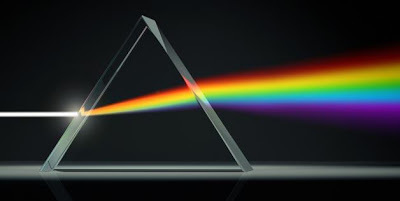
Other scriptures talk in a similar vein and describe the chariot of the Sun-god in much detail. Although
Arun-deva sits in front of the sun-god and is engaged in driving the chariot, he looks backward toward the sun-god. The chariot has a SINGLE wheel with 12 spokes and is yoked to seven horses.
Sixty
thousand saintly persons named Valkhilyas, each the size of a thumb, are
located in front of the sun-god and offer him prayers. The Gandharvs and Pannags sing in front of him, Apsaras
dance before the chariot while Nishachars and Yakshas follow and guard it. These seven groups of fourteen associates
arrange the proper times for regular snow, heat and rain throughout the universe and are responsible for maintaining the Seasons on Earth!
Chariot of the Sun from a Tanjore painting
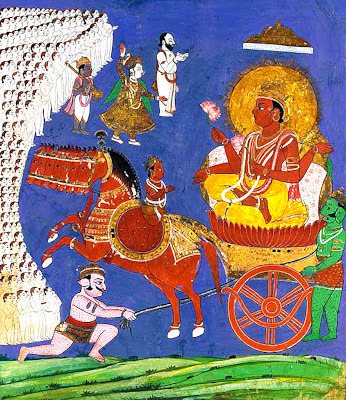
Not
surprisingly, a similar description is found in the description of
Greek/Roman Sun God Apollo's journey across the sky and I found a very
similar picture depicting this journey through the Heavens.

The Surya Siddhant further states:
'The carriage of the sun-god’s chariot is estimated to be 3,600,000 yojans [1 Yojan = 14.6 Km] long and one-fourth as wide. In
his orbit, the sun-god traverses a distance of 95,100,000
yojans at the speed of 2,000 yojans and two krosas in a moment.'
Scholars have used such references to calculate the speed of rotation of the Sun as well as its revolution! The Devi Bhagawat Puraan elaborates further in a description of Mount Meru and its surroundings:
O
Nârad! Mont Meru is situated towards the north of all the Dvîpas
and Varshas. So whenever any person sees the Sun rise he calls that side
“east.” If
the Sun travels in 15 (fifteen) Ghatikâs, the distance from Indrapurî to
Yamapurî, He is said to travel within that time a distance equal to 2¼
Kotis, 12½ lakhs and 25000 Yojans (22695000 Yojans).
Here, we also find the relevance of other aspects of the Sun's chariot. The SINGLE WHEEL of the chariot represents ONE YEAR or the Samvatsar while the 12 spokes represent 12 months! The THREE-naves of the wheel more likely than not represent the three points of an elliptical orbit!
All these poetic allegories thus give a glimpse into the scientific acumen that the ancients had. The reference to Saturn (Shani) being the Son-of-Surya could even be a reference to the planet having been formed from a chunk of the gases escaped from Sun's own body mass! (Just like the Sun, Saturn and Jupiter are also gaseous giants unlike other planets of the Solar System).
Formation of the Solar System
Formation of Planets
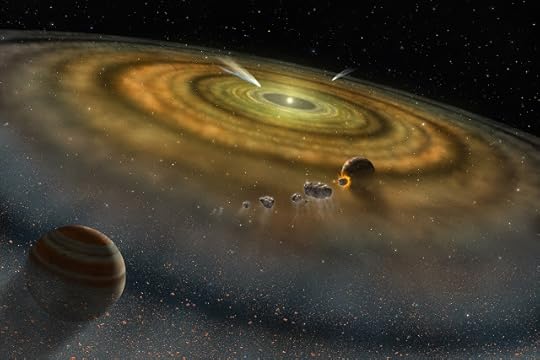
Without the Sun, we wouldn't have existed.. not only because of the Solar energy it provides but the planets including Earth wouldn't have taken form without the gravitational power of the Sun!
Our Earth is really tiny compared to the Sun and to share another interesting allegory, you would be surprised to know that the Sun-Earth distance is roughly 108 Sun diameters and the diameter of the Sun itself is 108 times that of Earth. The ancient Rishis and Magi of Hinduism quite possibly knew this relationship as most Gods/Goddesses have 108 names ascribed to them!!
This Sankrant, let us bow to the sages of yore and their (literally) out-of-the-world insight while sending a prayer of thanks to the Sun-God who maintains our Solar System.
Wishing everyone a Happy Uttarayan 2013 and a very Happy Lohri/Bihu/Maghi/Pongal and Makar Sankranti :o)
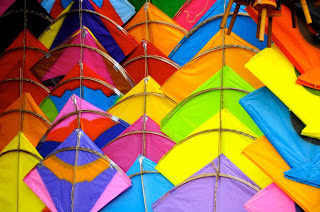


.
Aum Shanti: Shanti: Shanti:
.
Published on January 11, 2013 21:55
November 5, 2012
Rama - History behind the Legend
Aum Namah Raghukul-shiromani Kaushalya-nandan Dashrath-putra Shri Raam
{I bow to Lord Rama, The Son-of Dashrath, Born-of-Kaushalya, Scion-of-the-Raghu clan}
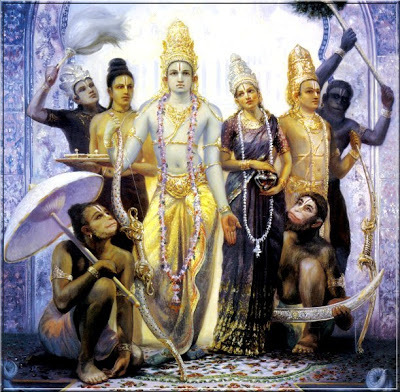
Since the auspicious home-coming of Shri Raam (Deepawali) is nigh, I thought of writing a post on my favorite Lord. As recognized by the Supreme Court of India, the existence of Shri Raam can not be decided only by historical or scientific evidence, it is a matter of faith to millions of people.
Yet, it is my effort in this post to analyze the historical and literary evidence pertaining to Lord Raam just as we did in the post on Lord Krishna {Krishna - The Historical Enigma}.
The primary source of life and journey of Shri Raam is the epic Ramayana composed by Maharishi Valmiki. The learned sage wanted to write an epic that would serve as an inspiration for generations to come, and highlight the ideals of human behavior in various roles assigned by the society.
Devarishi Narad, the spiritual mendicant of the Heavens, suggested to him to write about the life and times of Shri Raam, the doyen of the Suryavanshi clan and the most beneficient ruler the land had ever seen.
This acknowledgement is mentioned in the Valmiki Ramayan itself and is our first suggestion that the story was based on an actual historical figure. Ramayan itself declares that it belongs to the genre of Itihasa (History) and the only other two sacred books in that genre are the Mahabharat and the Harivamsha.
Other Literary Evidence for Rama
Besides Valmiki Ramayan (4th century BCE), many other scriptures also attest to Shri Raam's existence. Vishnu Puraan declares Rama as Lord Vishnu's seventh incarnation, and the Bhagavat Puraan, recounts the story of Lord Rama in the 9th Skanda and counts him amongst the 24 major incarnations of the Vishnu Tattva.
The Epic Battle between Forces of Good and Evil
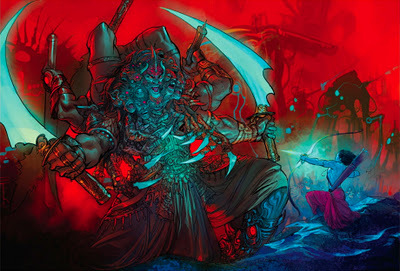
{Image courtesy - Grant Morrison's 18 Days}
Mahabharat also mentions the story of Rama in the Aranyak Parva, Dron Parva and the Raam-opakhyan where its is narrated to the eldest Pandav,
Yuddhishthir. Shri Raam Avatar also finds place in the Harivansh and the Agni Puraan. Not only these scriptures from Hindu literature,
but Buddhist and Jain texts also record the story of Rama and mention it in
their own respective styles:
In Buddhism, Ramayan is present in the form of Dasarath Jatak, Dasrath Kathanak and Anamak Jatak, the first of which was composed in the 2nd century BCE. This version talks of Rama and Sita
as siblings (which is a common symbolic
imagery in early Buddhist literature to denote purity of a dynasty).
In Jain literature, Ramayan exists as the Padma Charita, Charitra Puran, Padmachariyam etc. where, Rama, Lakshman and Ravan represent the Baladev, Vasudev and
Prati-vasudev concepts of Jain mythology respectively. Keepin with the Jain tradition of non-violence, it is Lakshman who kills
Ravan and due to the use of violence, both go to hell
while Lord Rama (known as Padma) goes back to heaven.
All
these unrelated sources chronicling the life of Rama can not be false or
fake.. There has to be SOME reason that ALL these diverse traditions
decided to write about Shri Raam and share His life story! However, even with all this literary evidence, we do not have much archaeologically to help us in our endeavor like we did for Krishna in the post {Krishna - The Historical Enigma}, and the reason for
that will be clear soon enough!
To illustrate my point, I share the following excerpts declaring the time of arrival of the 7th Avatar of lord Vishnu on our Planet:
Treta yuge chaturvinshe ravane tapseh shakshyat |
Ram dashrtathi prapiye sagane shakyamiyeewan ||
[Vayu Puraan 70.88]
Chaturvinshe yuge chapi vishwamitra pure sare |
Loke ram iti khyate tejsah bhaskaropam ||
[Harivansh 22.104]
Chaturvinshe yuge vats tretayaam raghuvanshaje |
Ramo naam bhavishyami chaturvhayu sanatane
||
[Brahmand Puraan 2.2.36.30]
On the basis of the
given references it can be inferred that Shri Raam lived in the 24th Treta Yug. The Mahabharat further elaborates the exact timeline to the juncture of the Treta and the Dvapar Yugs:
Sandho tu samanupraptre tretayaam dwaparisya cha |
Ramo daasrathirbhutva bhavishami jagatpati ||
[Mahabharat 348.19]
Now this is ground-breaking information people and I will tell you why!
We are currently in the Kaliyuga of the 28th YUGA CYCLE of the 51 st Day of Brahma. Hence Lord Rama was born not just Two Yugs ago but TWO YUGS plus THREE CHATUR-YUGS before present!!
THIS is why digging for archaeological data to corroborate the existence of Shri Raam would be futile. There is no way we could find any man-made artifacts after millenia as the scriptures put Shri Raam's period to be 18 million years ago! Even if we consider this duration to be in Deva Years, it comes to more than 40,000 years. {For relation between Deva and Human Years, check the page Kalchakra of this blog}
For the same reason, 7323 BCE or 5114 BCE as the birth years of Shri Raam can not be correct. Even though the dates were arrived at through a thorough analysis of Lord Rama's birth charts and have a very sound basis but based on what scriptures say, we have to make a correction in them.
These analyses done by Prof. Vartak and Pushkar Bhatnagar show that at a certain point in time, the planetary configuration mentioned at the time of Lord Rama's birth DID indeed exist and thus, the numerous astrological references in the Ramayan are not imaginary but refer to ACTUAL points in time.
Alignment of Stars at the time of Lord Rama's birth
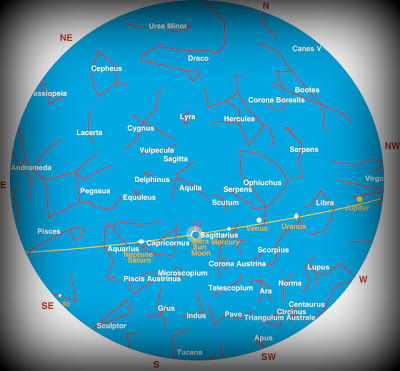
A solution to the apparent mismatch of dates can be found if we realize that because of a phenomenon known as the 'Precession of Equinoxes', stars as visualized from Earth, regain the same positions every 26,000 years! Hence, this particular permutation of stars could belong to 5114 BCE + 26,000 or 26,000 years before that or the similar period before that or the one before and so on and so forth..
What is amazing is that even today the places related to Lord Rama, the
stories, the Geographical co-ordinates of the cities mentioned etc. are
still remembered in the Hindu tradition! Therefore, what we can still do is track and analyze this GEOGRAPHICAL evidence in the literary masterpiece of Ramayan and find out if they help us in our cause.
Ramayan - The Adi-kavya
Numerous versions of Ramayan exist throughout the length and the breadth of the country and even outside its boundaries but the oldest of these is the Valmiki Ramayan and for our analysis, we will stick to the original as it is the most ancient and accurate one.
Let me begin with a very interesting anachronism mentioned in this version of the Ramayan.
Sundar Kanda [4.27.12] states that Hanuman, on entering Lanka, sees FOUR-TUSKED elephants guarding the palaces of Ravan. These elephants are tall and imposing and have been trained to protect Lanka from invaders. A similar account is given by Trijata, the ogress guarding Sita ji in Chapter 27 of the same Kanda when she dreams of Lord Rama coming to Sita's rescue riding an elephant high as a hill and bearing four-tusks.
So what is so special about these accounts?? Well, fossil remains show that there were many steps in the evolution of the 'Modern Elephant' and there DID exist four-tusked ancestors of elephants in various shapes and sizes such as Trilophodon, Tetralophodon, Gomphotherium etc that survived from roughly 20 million years ago to 4 million years before present!
How in the world could Rishi Valmiki have known about the four-tusked ancestors of the modern elephant unless he had seen them himself or was told about them by Narad???
Four-tusked elephants mentioned in Ramayan lived millions of years ago!
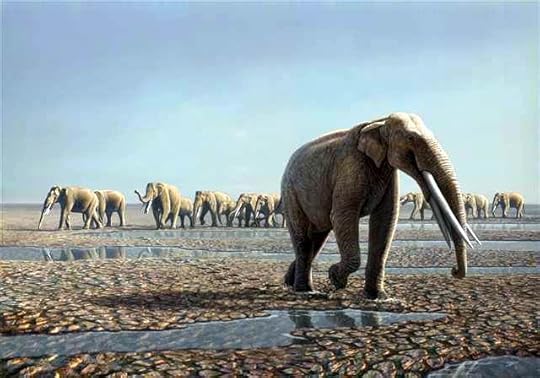
This apparent anachronism, though not rock-solid evidence, is yet another point that puts us in a time frame closer to what the scriptures say. Another such account comes from the Yuddha Kaand of Ramayan [Verse 4.114] that mentions the moat around Lankapuri to be teeming with crocodiles, Makars, whales and Timingilas.
This last mentioned animal's name literary means - Whale-gulper which means this particular aquatic being was big enough to gulp down even large whales. Is such an animal even possible?? You would be surprised to know that the answer is yes! A giant shark known as the Megalodon did exist on the planet 16 to 2.6 million years ago quite close to our envisioned time period.
Timingila/Megalodon mentioned in the Ramayan
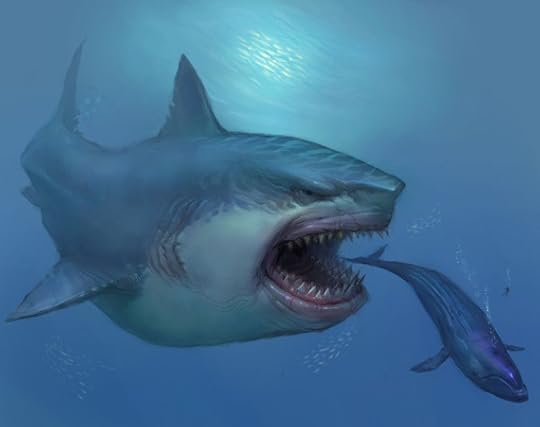
Let us now see what geographical evidence we can glean out of the masterpiece of Valmiki Ramayan that forms the foundation of cultural traditions right from India to the Far East and check whether the Ramayan contains accurate information or describes a make-believe land.
Geographical Evidence from Valmiki Ramayan
Ramayan (Travels of Rama) itself indicates a Geographical journey. The story begins in Ayodhya (The-Unconquerable-City), the center of power for the ruling Suryavanshi/Solar Dynasty kings.
Shri Raam's mother Kaushalya was from the kingdom called Koshala, which corresponds to the state of Chattisgarh of today. Sumitra was from Magadh (Bihar) while Kaikeyi was from above Gandhar, the kingdom called Kaikeya which is today's Waziristan.
The journey of Lord Rama to recover Sita ji covers the length and breadth
of the country and Valmiki Ramayan is extremely correct
Geographically.
Major Kingdoms of the sub-continent in Ramayan Times

The authenticity of Geography right from Gandhar to Sri Lanka can not be the result of imagination!
Before being judgmental, we should remember that this was in a time when the modern means of transport/communication/internet etc. were not available. It has to be based on actual witnessing of these places by either the
author or the one narrating the story to him, who in this case was Devarishi Narad.
Sites within India
Let us begin with Shri Raam's birthplace Ayodhya which although in dispute because of the political battle centered around it, can still yield a lot of information.
To begin with, we have to answer the million dollar question - did an ancient temple exist at the disputed site in Ayodhya? Indeed, before the demolition of Babri Masjid, there had been excavations around the temple precinct which gave indications of not one but many older temple foundations existing there.
The Imperial Gazetteer of Faizabad (1881)
confirms the construction of three Moghul mosques at Ayodhya on the site of
three celebrated shrines: Janmasthan, Swargadwar and Treta-ka-Thakur.
Archaeological Survey of India tells us that Mir Khan (on Babar's orders) built
the mosque at Janmasthan using many of its columns. The other two
mosques were built later by Aurangzeb who was one step ahead of Babar in his zealotry.
From 1975 to 1980, the Archaeological Survey of India had under the guidance of Prof. B.B. Lal, unearthed (literally) as many as 20 black stone pillars, 16 of which formed the base of the 'Janmasthan Masjid' as it was called colloquially even then. The pillars were much bigger in size than those of the mosque and clearly belonged to a much more grand structure.
Check out the man on the left as reference for the size of the pillars

On further stratigraphic and other evidence, Prof. Lal also found a door-jamb carved with Hindu icons and
decorative motifs of yakshas, yakshis, kirtimukhas, purnaghattas, double lotus flowers
etc.
Excavation was resumed on July 2, 1992 by S.P. Gupta, Y.D. Sharma, K.M.
Srivastava and other senior archaeologists barely six months before
the demolition. Prof.
Lal's southern trenches had missed a huge pit
with 40 and odd sculptures just by 10 to 12 feet discovered by the team even though he DID get the pillar
bases which others did not get later.
Excavations at Ram Janmabhoomi Sthal
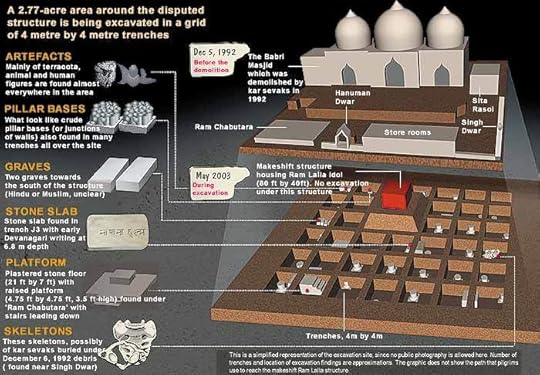
The
team found artifacts ranging from the 1st
through the 12th century CE! These findings included religious sculpture, terracotta images from the Kushan period (100-300 CE) and a statue of Lord Vishnu. They concluded that these and other fragments such as the amakalas, or
the cogged-wheel crown of the spire belonged to a temple of the North Indian Nagara style of Temple architecture (900-1200 CE).
The most important finding is what is known as the Hari-Vishnu Inscription written in 12th
century CE Devanagari script. Line 15 of this inscription clearly tells us that
-
A beautiful temple of Vishnu-Hari, was built with heaps of stones and
beautified with a golden spire unparalleled by any other temple built by
earlier kings... This wonderful temple was built in the temple-city of
Ayodhya situated in Saketamandala.
Line 19 describes god Vishnu as
destroying king Bali and the ten
headed Dashanan, i.e., Ravan.
Hari-Vishnu Inscription from Babri Masjid excavation
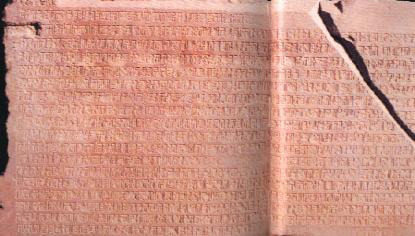
Archaeology records at least two destructions: the FIRST in the 12th-13th
century; the SECOND in the 16th. This agrees well
with history and tradition that temple destructions followed the Ghori
invasions (after 1192 AD) and again in 1528 by Babar
who replaced temples at major Hindu pilgrimage sites with mosques.
Moving on, Sita ji was discovered by Janak in Mithila which now lies in Nepal. It forms a region shared by both India and Nepal and gives birth to the language known as Maithili. The place where the Goddess was found by Raja Janak in a furrow is known as Sitamarhi, and is still revered along with the nearby pond called the Janaki kund.
After their wedding, Shri Raam and Sita ji left for Ayodhya via Lumbini where we have an Ashoka Pillar from 249 BCE, with an inscription referring to the visits by both
Rama and Buddha to Lumbini.
When they were exiled, Lord Rama, Lakshman and Sita went to Shringverpur in Uttar Pradesh where they crossed the River Ganga. They lived on the
Chitrakut hill where Bharat met and pleaded for their return. Thereafter, the three wandered through
Dandakaranya in Central India, described as a land of Rakshasas and tribals.
The Journey of Lord Rama
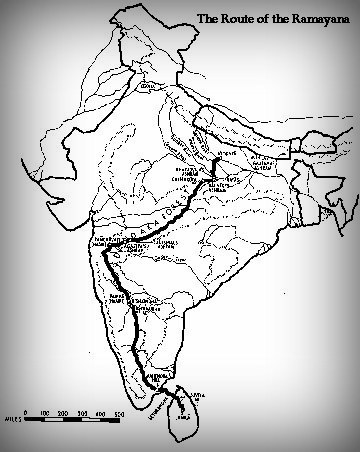
After spending some time there, they reached Nashik, near river Godavari, and the region
throbs with sites related to the three Ayodhya-vasis. There is the place where they built their cottage known as Tapovan; Ramkund where Rama and Sita used to bathe, Lakshmankund, for the younger brother's
bathing area, and several other caves associated with their lives in the
forest.
Shri Raam, Lakshman and Sita ji inTapovan

The three then moved to Panchavati, near Nashik in Maharashtra, from where Ravan, with the help of his uncle Mareech, was successful in abducting
Sita ji. On the way to Lanka from Panchavati, Ravan was attacked by Jatayu but died a martyr's death. The place where this happened is in Andhra Pradesh and has a beautiful temple dedicated to Shiva and Jatayu's sacrifice is recorded in the name of the place - Lepakshi which in Telugu means 'Rise, bird' referring to his soul leaving the body when he breathed his last in the lap of Shri Raam.
Me at Lepakshi temple in Andhra Pradesh
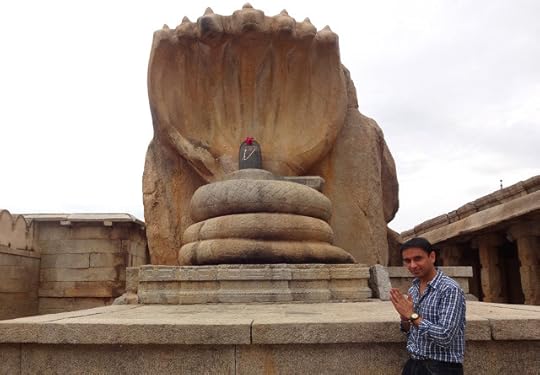
Sita ji dropped her valuables all along the way that were gathered by the Vanars below and Shri Raam and Lakshman found those when they reached Kishkindha, near modern Hampi, where they first met Hanuman and then Sugriv, the exiled King of the Vanars. This is a UNESCO World Heritage site and Sugriv is described to have lived at Mount Rishyamukha on the banks of river Pampa (Tungabhadra). Anjanadri, near Hospet, is believed to be the birthplace of Lord Hanuman (Anjaneya).
Kishkindha, modern Hampi
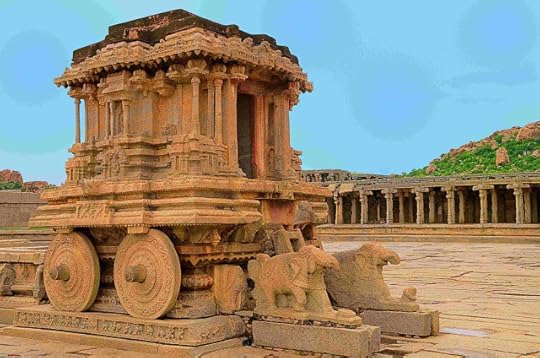
The Vanar army led by Shri Raam, Sugreev, and Jambvant then reached
Rameshwaram, where they built a bridge to Lanka from Dhanushkodi on
the Rameshwaram Island to Talaimannar in Sri Lanka. While parts of the RAMA-SETU are still visible, NASA had in the early part of this millenium photographed an
underwater man-made bridge of shoals in the Palk Straits, connecting India to Lanka.
Shri Rama Setu connecting Shri Lanka to the Indian mainland

The
existence of Rama Setu had already been confirmed by several foreign travelers
including the Venetian traveller Marco Polo (1254-1324), and British cartographers who prepared maps of the area in 1747,
1788 and 1804. The then Manual of the Administration of Madras
Presidency mentions both the names Adam’s Bridge and Rama Setu. It also says that
the Setu was used for pedestrian traffic between India and Sri Lanka
right until 1480 when a major cyclone destroyed it!!
The Bridge of Rama


Accurate dating of this bridge can help us in finding an answer but since different studies have come up with different dates, I prefer not to mention them here. Let us now shift our focus to Lanka and try to find out whether there is any geographical location matching with the descriptions in Valmiki Ramayan.
Sites in Sri Lanka
Once Ravan had captured Sita ji, he brought her to the place today known as Weragantota in
Lanka close to Mahiyangana town; and surprise surprise the meaning of this name in the Sinhalese language is a 'landing place for aircrafts'!!
According to the depiction of Pushpak Viman (which Ravan had snatched from his half-brother Kuber), it resembled a
huge peacock. In Sinhala it is called the Dhandu Monara (flying peacock) and it is believed that Ravan had an aircraft repair
center at Gurulupotha where Sita ji was first brought and quite fittingly, the name means
"parts of birds". Right next to it is the Sita Kottuwa jungle in which once stood the city of Lankapura.
Ramayan sites in Sri Lanka
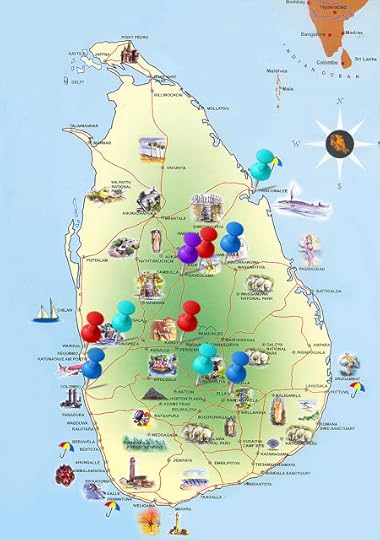
Ashok Vatika is the garden where Ravan is supposed to have held Sita ji captive and this is in the
area of Sita Eliya, close to the popular hill station Nuwara Eliya. The Sita Pokuna is a
barren area atop the Hakgala Rock Jungle where Sita ji was kept captive and the
Sita Amman Kovil (Temple) is located here and I was fortunate enough to have paid it a visit last year :o)
The Sita Amman Temple near Nuwara Eliya

About 50 Km from here is the Divrumpola Temple which is thought to be the place where Sita ji performed her ‘Agni Pariksha’. the name means 'a place for making a vow' and is
seen inscribed in the moonstone guarding the Temple.
The summit of the mountain next to the Frotoft Tea
Estate in Pussallawa is the place where Hanuman is believed to have first set his foot on Lanka! This mountain known as Pawala Malai stands between Ravan’s capital city and
the Ashok Vatika.
The Sita tear pond is found en route by the chariot route, and is believed to
have been formed by the tears of Sita devi. The forest is also colored with the famed Sita Flowers which are endemic to this area. The peculiarity of these flowers
is the configuration of the petal’s, stamen and pistils, which resemble a human
figure carrying a bow, and is said to represent Lord Rama.
Sita flowers

Ella, a small mountain near Bandarawela, boasts of three locations
linked to the Ramayan where, local legend dictates, Ravana hid Sita.
First there is the Ravana Ella Cave situated in the massive Ella Rock.
Then there is Ravana Ella Falls and a nearby pool bored out of the rock
by the gushing waters. The tunnels in
the Ravan cave believed to have served as a quick means of transport through the
hills and also as secret passages.
Ravana Falls in Lanka

The Kelani River is mentioned in the Valmiki Ramayan and
Vibhishan’s palace was said to be on the banks of this river. Vibhishan is still considered one of the
four guardian deities of Sri Lanka, and temples for Vibishan are found
throughout Sri Lanka unlike that of Ravan.
There are many more spots connected to the Legend of Shri Raam and a complete list can be found at the following link - {Ramayana_sites_in_sri_lanka}.
Ravan, the Lord of Lanka, a mighty warrior, a learned pandit, the master of Three Worlds, the posessor of Amrit, was ultimately defeated by the hands of Shri Raam because in his hubris, he desired what belonged to the Supreme Lord Vishnu Himself.
He sacrificed the lives of his brother, his sons and his entire army just to pander to his ego. Despite all his knowledge and erudition, he was not able to get a grip on his desires and lust which ultimately led to his downfall.
Lord Rama ready to unleash the final arrow on Ravan
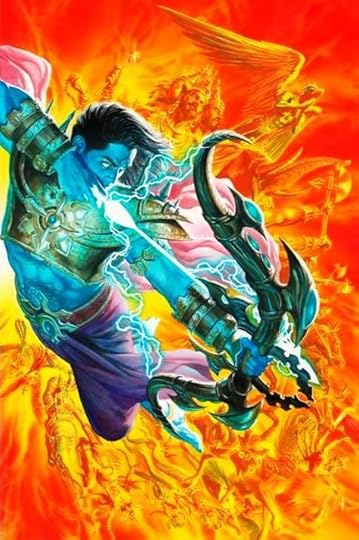
{Image courtesy - Ramayana 3392 A.D.}
Outside
India, the millenia old story of Rama is still sung by people all over
Asia. While traveling to different countries in this part of the world, I
have come across versions that are even older than the regional ones in
India!!
In China, collection of Jatak
stories relating to various events of Ramayana, belonging to 251 AD were
compiled by Kang Seng Hua based on the Buddhist texts mentioned earlier.
Kumardasa, who ruled Srilanka in 617 BCE wrote the text called ‘Janakiharan’ which is the
oldest Sanskrit literature available in Sri lanka.
Oldest written version of Ramayana, in Nepal is from 1075 BCE.
Yama Zatdaw in Myanmar
is considered the National epic and is a Burmese version of the story
of Rama which has again given theme to dance and art forms including
tapestries and puppets.(In fact my Burmese friends even stressed that it
is the true history of their land).
The retelling of Ramayana in Myanmar's National Epic
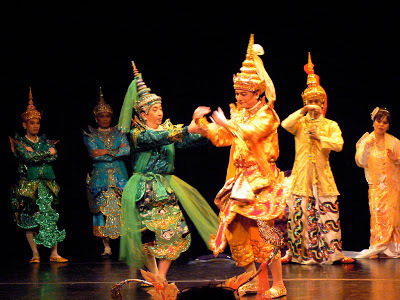
Hikayat Seri Rama
in Malaysia makes Dashrath the great-grandson of Adam, the first man!
(which is not too far from the truth as both
Dashrath and Manu, the First Man were from the Suryavanshi/Solar dynasty!),
In the Phra Lak Phra Lam of Laos,
Buddha is regarded as an incarnation of Rama (again not
completely false as both are incarnations of Lord Vishnu!).
Reamker, is the most famous story of Khmer Literature of Cambodia and is the source of classical dance, theater, poetry and of course the famous sculptures of Angkor Wat. Various
rock inscriptions belonging to about 700 CE are also found in the Khmer region of
Cambodia.
Ramayana depictions from Angkor Wat, Cambodia
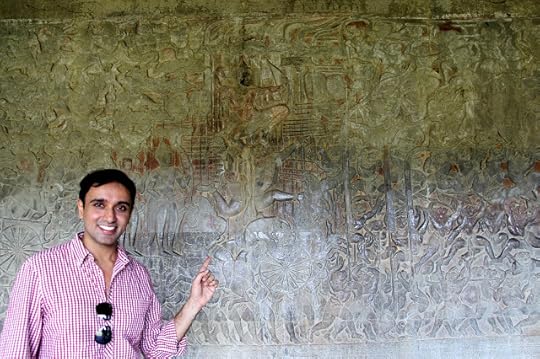
Maradia Lawana in the Phillipines is based on the Ramayana,
Ramakavaca
in Bali is a major source of moral and spiritual guidance for the
island and forms the basic story line of Balinese traditional dance,
Kakawin Ramayana in
Java, Indonesia (9th century CE) is a mixture of Sanskrit and Kawi
languages and is the basis of traditional Indonesian ballet and
performances that are famous the world over.
Indonesian Ramayan Ballet


Ramakien in Thailand
is again considered the National epic and adds an element of incest to
the story by making Sita the daughter of Ravan and Mandodari who is
thrown away in the Sea as she is prophesied to bring destruction to
Ravan's Kingdom!!
However, the abandoned baby Sita is
found by Janak and grows up as his daughter only to be later abducted by
Ravan and ultimately lead to the end of Ravan and his supremacy.
Thai Khon Dance based on the Ramayana
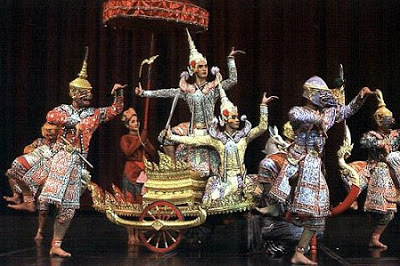

Notably, the capital of the Thai kings was also referred to as Ayutthaya
the Thai version of Ayodhya! Even the current king in Thailand has the title of Rama IX.. never imagined travel to these parts of
the world would open my eyes to the richness of our own heritage.
This Diwali, let us once again remember the story of the great personality that has influenced generations of humans and has survived over millions of years. I conclude this Deepawali post with the closing lines of the poetic rendition of Ramayan by Romesh C. Dutta:
"Mark
my love," Rama told Sita, on the Pushpak car,
As the home-bound couple, left behind the field of war,
"Watch Lanka's
proud city below on the triple crest,
Like peaks of Kailash mansions where Immortals rest.
Mark
the gory fields, where Vanars in their might,
Fought the charging Rakshasas, in the gory fight,
Where Indrajit
and Kumbha-karna, Ravan and chieftains,
Fell down in battle with their blood soaking the plains.
See
my love, around the island how the oceans roar,
Hiding pearls among corals, strewing shells upon the shore,
And
the causeway mighty, monument of our fame,
'Rama's Bridge' to distant ages shall our deeds proclaim!
See
the rocky Kishkindha and her mountain-girdled town,
Where I slayed Vali, and placed Sugriv on the throne,
Watch the hill of Rishyamukh, where the Vanars first I met,
Gave them word - Sugriv will be king ere the Sun had set.
Watch the sacred Pampa by whose wild and echoing shore,
I poured lamentations, when I saw my wife no more,
And
the woods of Janasthan where Jatayu fought and bled,
From where the deceitful Ravan, with my trusting Sita fled.
Dost
thou mark, doe-eyed Sita, the cottage on river bank,
Where in righteous penance, we laid down every plank,
And the mighty Godavari, with Saint Agastya's home of love,
Where holy men through holy duties sanctify the grove.
Dost
thou, o'er the Dandak forest, view the Chitrakut hill.
Where the deathless bard Valmiki, lives in the crystal rill,
Thither
came the righteous Bharat and my army came,
Longing to take us back to Suryavanshi's town of fame,
Dost
thou, devoted Sita, see the Yamuna in her might,
Where in Bharadwaj's ashram passed we, a happy night,
And
the broad and ruddy Ganga sweeping in regal pride,
Where forest-dweller Guha crossed us to the southern side.
Joy!
joy! gentle Sita! Fair Ayodhya looms above,
Ancient seat of Raghuvansh, Our Hope and our Love,
Bow,
bow, to bright Ayodhya! Dark did our exile roam,
But tonight our weary toil ends, in Suryavansh's ancient home!"
Jai Shri Raam and Happy Diwali :o)
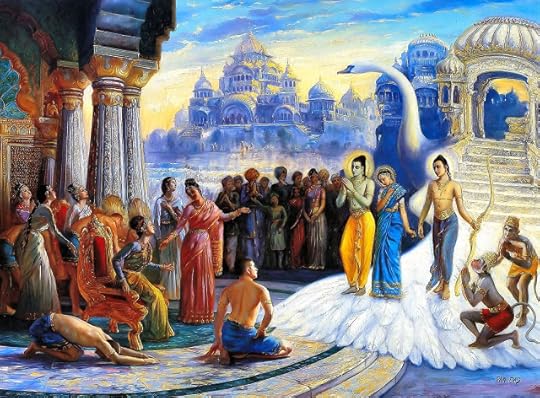
Let there be Light
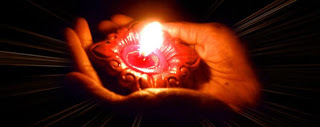
.
Aum Shanti: Shanti: Shanti:
.
Published on November 05, 2012 10:43
October 1, 2012
Quest for Dwarka
The sea, that had been beating against the shores,
broke the boundaries imposed by nature..
It rushed into the beautiful city,
and swallowed everything in its path..
I saw the grand buildings submerge one by one,
In just a few moments it was all over..
The sea had now become as placid as a lake,
There was no trace of the city anymore,
Dwarka was just a name; just a memory..
What a terrible end to witness, the submergence of an entire metropolis in front of one's own eyes.. Yet, this is what happened to the golden city of Dwarka and according to Mahabharat's Musal Parva, Pandav Arjun was eyewitness to this destruction!
In continuation of my previous post {Pralaya - The end of Days}, I decided to explore the topic further and assess its impact on Indian history. It leads me to believe that civilization hubs on the shores of our vast peninsula have succumbed to these calamities time and again, and Dwarka, was one of the most promising candidates for such a catastrophe.
What exactly was Dwarka? We know
from ancient texts that the city was located on the western shore of Indian mainland; we know it was the capital of Yadavs after they
migrated from Mathura; we know Lord Krishna
made the city His capital and ruled the kingdom from there; and we also
know, that this fabled city was submerged under huge Tsunamis as soon
as Krishna left the Earth.
Let us now dig a little deeper and find out more about the rise and fall of Dwarka.
Dwarka, the Golden City
Dwarka or Dwarawati (The-city-of-Doors) finds mention in many Sanskrit epics including the Mahabharat, Harivansha, Bhagvat Puraan, Skanda Puraan and the Vishnu Puraan. It is one of the sacred quartet that forms Char Dham of Lord Vishnu along with Shri Badrinath, Shri Jagannath Puri and Shri Rameshwaram.
Shri Dwarkadhish Temple in the modern city of Dwarka
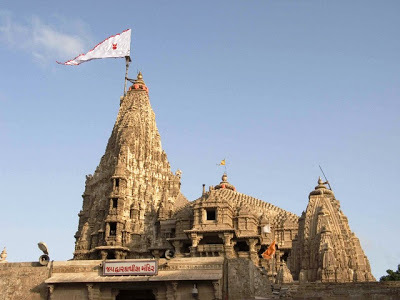
My visit to the ancient temple
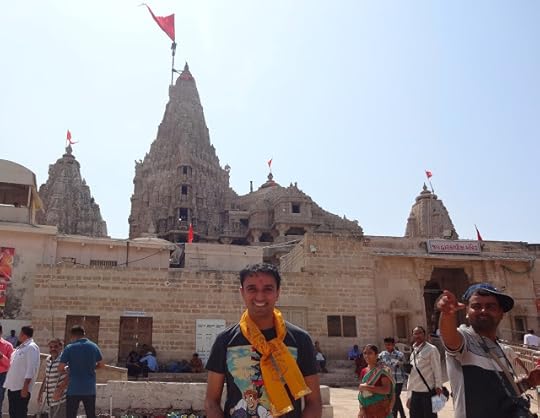
Legend says that the city was built by none other than Vishwakarma, the architect of demigods on the order of Lord Krishna at a site
selected by the Divine Eagle Garud.
Krishna's Golden City from a Mughal miniature painting
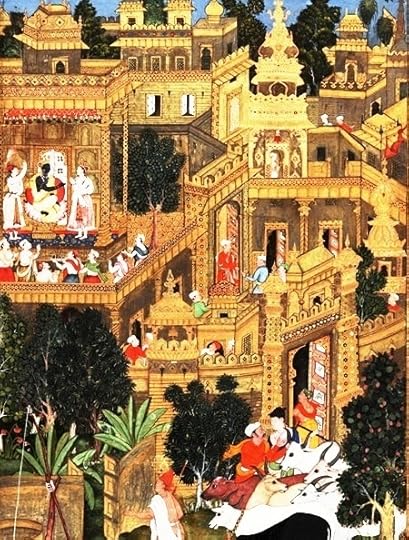
In order to know more about the creation of Dwarka, we would first have to understand the geo-political realities of the time. Let us take a look at the political dynamics in the country at the end of Dvapar Yuga.
Socio-political Condition in Mahabharat Times
The end of a Yuga is always a phase of tumultuous transition. We are talking about the period from the Dusk-of-Dvapar to the Dawn-of-Kaliyuga and there was a lot of political upheaval at this time in the civilized world.
Jarasandh, the king of
Yadavs were settled on the banks of Yamuna and the cities of
Another Yadav prince Samudravijay was ruling over Shauripuri, while his younger brother Vasudev (the father of Krishna) was the captive of Kamsa along with his wife Devaki. When Krishna grew up, He liberated His parents from the dungeons of Kamsa, killed the despot and ended his reign of tyranny but Jarasandh (Kamsa's father-in-law), vowed to take revenge.
Since Krishna was too strong an adversary, Jarasandh, who was a master strategist, decided to target the Yadav subjects and launched a series of raids against the denizens of Mathura. Krishna, being a statesman par excellence, decided to wait for the right time (aka the Mahabharat War) and meanwhile thought of a way to secure His countrymen.
He decided to move the entire population of Yadav kingdom to a place far beyond the reach of Jarasandh and picked the western
coast of India. The Sabha Parva of Mahabharat gives a
detailed account of Krishna's emigration to
Dwarka in order to save
the lives of His subjects from unwanted attacks.
Migration routes of various clans due to Jarasandh's attacks

Krishna summoned Vishwakarma, the divine architect of the demigods, and commissioned a city that would be the
envy of the civilized world. However, the architect wanted to reclaim some land from the sea and the task could be completed only if Varundeva,
the Lord of the sea, acquiesced to this proposal. Sri Krishna worshiped Samudra-dev,
who gave them land measuring 12 yojans and Vishwakarma
then built the magnificent Dwaraka, a city in gold.
This is what we know from the Mahbharat, let us see what other literary evidence we can gather from other sources.
Historicity of Dwarka - Literary Evidence
According to the Garuḍa Purāṇ [1.16.14], Dwarka was one of the seven ancient cities in the country that are believed to lead one to Nirvana.
Ayodhyā Mathurā Māyā Kāsi Kāñchī Avantikā
Purī Dvārāvatī chaiva saptaitā moksadāyikāh
Inclusion
of Dwarka in this list gives reason that it would have been a
historical city as the other six cities mentioned in the verse are very
much alive and thriving even today.
Other scriptures record that the city was built on the sunken remains of a previous kingdom,
Kushasthali, which itself was built on older ruins. The modern city of Dwarka is located in the westernmost part of India at the confluence of the Gomati river with the sea.
Western region of the Indian mainland
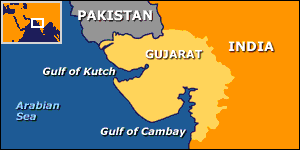

Rishi Ved Vyas has described Dwarka in great detail and calls it 'A city so golden
that it cast its radiance on the ocean for miles around it'. The city extended over 104 Kms and was divided into six well-organized sectors, residential and commercial zones, wide
roads, plazas, palaces and many public utilities.
It had a special hall
called Sudharma Sabha to hold public meetings and the city had beautiful gardens filled with flowers of all
seasons and beautiful lakes. It was well fortified and
surrounded by a moat, spanned by bridges, boasted of a good sea harbor
and had an incredible number of 700,000 palaces made of gold, silver and other precious stones!
The city of Dwarka
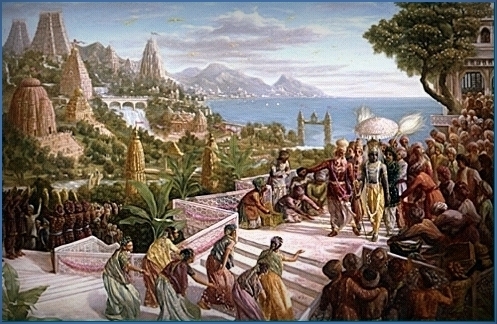
Narad Muni's visit to Dwarka
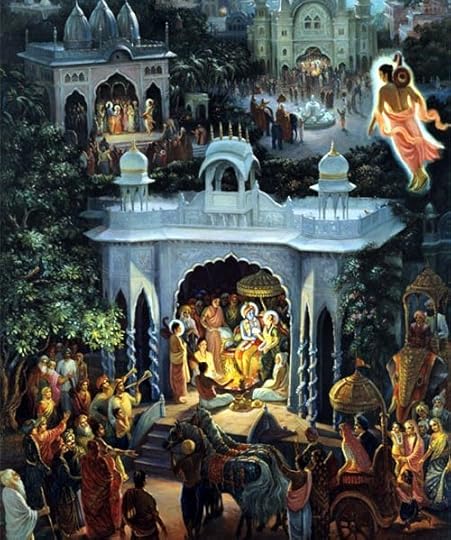
After Krishna departed from Earth, about 36 years after the Mahabharat War (3102 BCE), Arjun went to Dwarka to bring Krishna's grandsons and remaining Yadavs to safety. As soon as they left, the city was submerged into the sea and the eye-witness account is mentioned in the beginning of the post.
The Vishnu Puran also mentions the submersion of Dwarka, stating-
On the same day that Krishna departed from the earth, the dark-bodied Kali Yuga descended. The oceans rose and submerged the whole of Dwarka.
Besides Dwarka,
there are mentions in the scriptures of many renowned cities which were washed away by the rivers on whose
banks they were situated. Mahabharat mentions that Hastinapura was
washed away by the Ganga and consequently the Pandavas had to migrate to
Kaudambi.
Similar was the case with Pataliputra which, even though the premier city of the land,
later became the worst victim of inundation according to Dandin, the author of the Dashakumaracarita.
The question in front of
historians now is, whether these cities ever really existed or were they just a
figment of poet's imagination? Let us try to understand where
archaeology stands on this question.
Archaeological Evidence
Pargiter, a noted historian in British India, was the first to suggest that Dwarka was located near the Raivataka (Girnar) mountain and also mentioned that it was constructed on the remains of an earlier city known as the Kushasthali.
The Girnar mountain is considered holy not only by Hindus but is also a major site of pilgrimage for the Jain community. It is the place where the 22nd Jain Tirthankar, Lord Neminath (who BTW was a paternal cousin of Lord Krishna), attained liberation.
Girnar Mountain
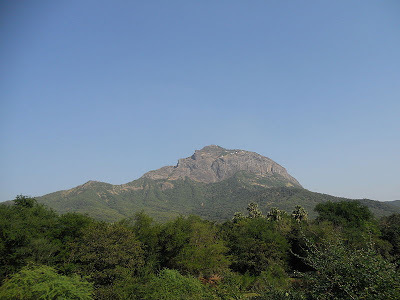
Jain Temples on top of Mount Girnar
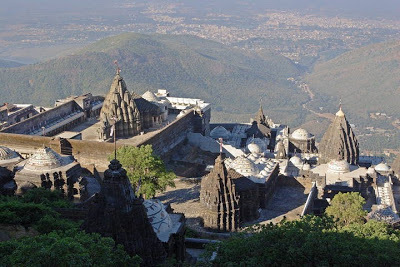
Jain legends tell many stories of both the brothers and acknowledge the presence of the Metropolis of Dwarka as being close to the Girnar mountains.
According to Jain texts, Shri Krishna
negotiated Neminath's marriage with Rajamati, (the sister of Kamsa), but
Neminath, empathizing with the animals that were to be slaughtered for
the marriage feast, left the procession and renounced the
world!
Interestingly, Jain tradition also recognizes Krishna as Vasudev and Jarasandh as the prati-Vasudev (similar to the Christ & anti-Christ belief) showing how important the rivalry between the two was.
The Yadav kingdom at that time spread around Junagadh district and the nearby Gir Forest (which is the last sanctuary for the Asiatic Lions today). The first excavations at the site were conducted by Deccan College, Pune and the Department of Archaeology, Govt. of Gujarat, in 1963 under the direction of H.D. Sankalia.
These and other archaeological excavations unearthed artifacts that prove that
modern Dwarka is the sixth settlement of the name on this site. The
earlier cities have been, at various times, swallowed by the sea. The
waves of the sea still lap the shores of this famous town, lending
scenic beauty to this important pilgrimage destination.
The sea adjacent to Shri Krishna Temple

Gradually, the myth of Dwarka was coming alive, but the final breakthrough came with the discovery of submerged remains of Dwarka by the Marine Archaeology Unit (MAU) jointly formed by the National Institute of Oceanography (NIO) and the Archaeological Survey of India (ASI).
Underwater Exploration of Dwarka
This exploration was undertaken under the guidance of Dr. S.R. Rao. Dr. Rao is widely considered widely the Grand-father of Indian Archaeology and has served the ASI for over 32
years. He is credited with the discovery of a large number of Indus-Saraswati sites
including the port city of Lothal in Gujarat.
Dr. S. R. Rao

Before the underwater ruins were discovered, most scholars were of the view that the Mahabharat was just a mythological epic and it would be futile to look for the remains of Dwarka. However, Dr. Rao and his team, undertook
an extensive search of this city along the coast from 1984-88 and finally succeeded in finding
the submerged city off the Gujarat coast.
The use of advanced techniques of geophysical survey combined with echo-sounders, mud-penetrators, sub-bottom profilers and underwater metal detectors helped uncover this missing link in our history!
Between 1983 to 1990, the well-fortified township of Dwaraka was
discovered, extending more than half a mile from the shore. In his work, The Lost City of Dwaraka, Dr. Rao has given scientific details of these discoveries and artifacts.
You can find a similar report report on the link - {Recent underwater exploration at Bet Dwarka and Okha Mandal }
Excavations at Dwarka


Offshore exploration of the legendary city was resumed in 1988 and continued through 1990, further seaward of the Temple of Samudranarayana (Sea God) with a view to trace the plan and extent of the port-city and
the purpose of the massive stone walls built on the banks of ancient
Gomati.
From the structural remains in Dwaraka and Bet Dwaraka waters, it is
possible to visualise that the city-ports were large and well planned.
The
findings of Bet Dwarka can actually be divided into two broad periods:
Protohistoric period which includes seal, two inscriptions, a copper
fishhook and late Harappan pottery; and the Historical period which
consists of coins, ship anchors and pottery.
Underwater exploration of Dwarka
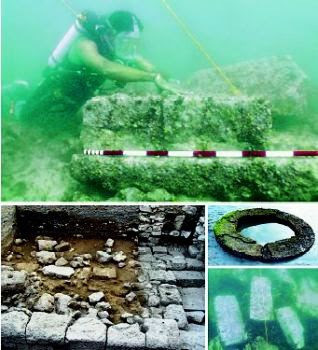
JUST AS DESCRIBED in the scriptures, the township was built in SIX sectors along the banks of a river. The foundation of boulders on which the city's walls were erected proves that the land was reclaimed from the sea.
The general layout of the city described in ancient texts agrees with that of the submerged city discovered by MAU. Mahabharat mentions a Prasada which corresponds to the high fort wall of Dwarka, a part of which is extant. The epic says that flags were flying in the city of Dwarka which can again be
corroborated by the stone bases of flag posts found in the sea bed
excavation.
Ruins of the Fort walls in Dwarka

A significant antiquity that further corroborates a statement of the Harivamsha
is the SEAL bearing the motif of a three-headed animal representing the
bull, unicorn and goat. The text states that every citizen of Dwarka
had to carry a seal as a mark of identification and the seal recovered
from the sea-bed matches with the scriptural description!
The seal of Dwarka
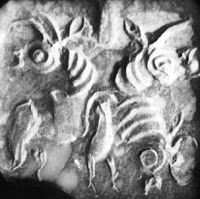
A
large number of rectangular blocks of various sizes are also scattered
in a large area in the vicinity and are evidently part of a single
structure. These blocks are lying on a rocky seabed and a few of them
are buried in sand.
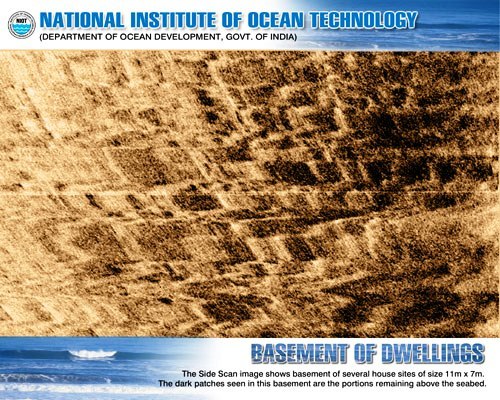
The UAW began excavations at
Dwarka again from January 2007. The objective of the excavation was to
know the antiquity of the site, based on material evidence. In the
offshore excavation, the ASI's trained underwater archaeologists and the
divers of the Navy searched the sunken structural remains.
According to the news releases made by the Govt. of India, the radiocarbon testing on a
piece of wood from the underwater site has yielded an age of
9,500 years which would place it near the end of the last Ice Age.
As discussed in the previous post {Pralaya - The End of Days}, the last melt-down was responsible for drowning a large number of civilizations all over the globe leading to the Flood Myths. This piece of wood could very well be a remnant of the same lost ante-diluvian civilization on the remains of which Dwarka was created.
Offshore explorations near Bet Dwarka jetty also brought to light a
number of stone anchors of different types that include triangular,
Indo-Arabian and ring stones.
These are made of locally available
rocks and their period may also be similar to those found at Dwarka and
other places. Recent findings have also shown evidence of active
Indo-Roman trade from the
fourth century BCE to 4th century CE.
Other artifacts recovered from the sea


All these findings should be able to build our faith in the belief that there indeed existed a port-city on the westernmost fringe of the Indian mainland which was into international maritime trade and hence would have been a popular and prosperous metropolis before its submergence.
The obvious next question is, what led to submergence of this massive trading city?
So what happened???
The answer lies in the progressive rise in sea-levels witnessed over thousands of years and tectonic upheavals taking place in the womb of the planet. These two combine like a potion being brewed in a witch's cauldron, and stir up giant Tsunamis capable of wiping out entire civilizations in one go!
In one of the major studies of its kind, scientists at National Institute of Oceanography have developed sea level variation history of the last ~14,500 years B.P. (Before Present), for the western coast of India.
To generate the sea level variation curve for these past 16,000 years, they had to compile all the data of past shore line indicators available between 21°N to 14°N latitude (till south of Saurashtra Peninsula). These dates ranging from 14,500 to 1,500 yr B.P. were then plotted against height/depth from which the dated material was recovered.
The sea level curve was then drawn based on geological reasoning and other supporting evidence such as the presence of terraces, nature of samples and inferences of sea-level rise from other stable areas.
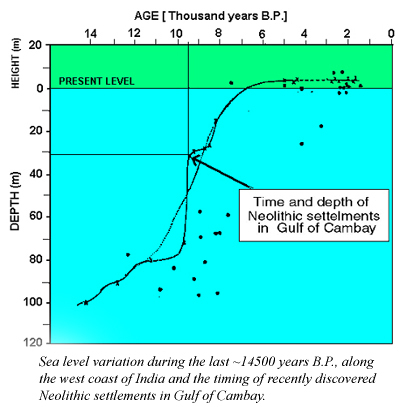
The curve shows that 14,500 years ago, sea level along the west coast of India was about 100m lower as compared to the present, and rose to 80m depth around 12,500 years ago with a rate of ~10m/1,000 years.
It was followed by a quiet period when the level remained unchanged for about 2,500 years, thus providing time for civilization to flourish before being
engulfed by the sea again. From 10,000 to 7,000 years ago, sea level rose at a very high rate (~20m/1000 years) and after approximately 7,000 years B.P. it has fluctuated to more or less the present level.
Animation depicting the shrinking of the Indian coast in years Before Present
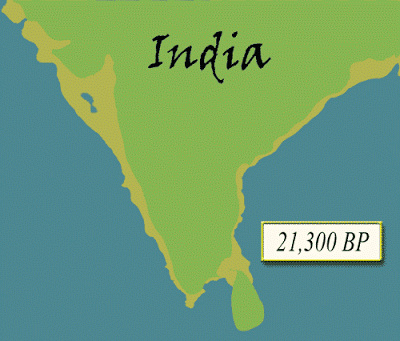
The animation above shows how the shoreline has changed over thousands of years, and how much land has been lost to the sea. All along the peninsula, we have most certainly lost civilizations at various stages of development and out of these, Dwarka was one of the most prominent ones.
In another study conducted on the Seismic activity in the Western region, work in peripheral land
areas of the Gulf of Cambay like Kathana, Lothal and Motibaur gave
evidences of major earthquakes in the following
periods -
(1) 2780 ± 150 years BP
(2) 3983 ± 150 BP and
(3) 7540 ± 130 BP
In the first major event at
about 7,600 BCE, the FIRST metropolis found in the underwater ruins appears to have succumbed to the tectonic forces and the sea appears to have inundated it. Because of
this catastrophe, people would have proceeded north to the higher sea level and established the SECOND metropolis.
This
also got affected by faulting due to earth quakes around 4,000 BP and
was destroyed by the second or the last Earthquake around 2780 ± 150 BP, when the
sea transgressed to completely submerge it.
We have experienced in the recent years how catastrophic submarine earthquakes can be. They do not affect the land directly but lead to huge waves that are meters tall and are capable of wiping out cities in minutes just as described by Arjun in the beginning of the post!
Giant Tsunamis generated by Submarine Earthquakes
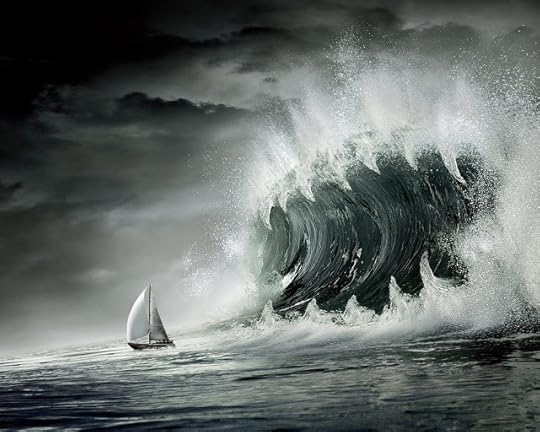
From our point of view, the older site of 7600 BCE could very well correspond to Kushasthali, the foundation of Shri Krishna's Dwarka and the second settlement of 4000-2800 BCE would then be the tentative time-frame of existence of the Golden City of the Lord.
This also matches very well with Shri Krishna's historical dates that we arrived at in the post {Krishna - The Historical Enigma} and again proves that our scriptures are not mere figments of fertile imaginations but have a historical basis.
Dr. S.R. Rao after his careful research made the following statement: "The
findings in Dwarka and archeological evidence found are compatible with
the Mahabharat tradition and removes the lingering doubt about the
historicity of the Mahabharat. We would say that Krishna definitely
existed".
Krishna, the Great Statesman and King was indeed a historical figure who ruled from the city of Dwarka until the day He departed from the mortal realm. He lived the life of a householder and raised His family in the city of Dwarka.
Krishna, the Yadav king of Dwarka
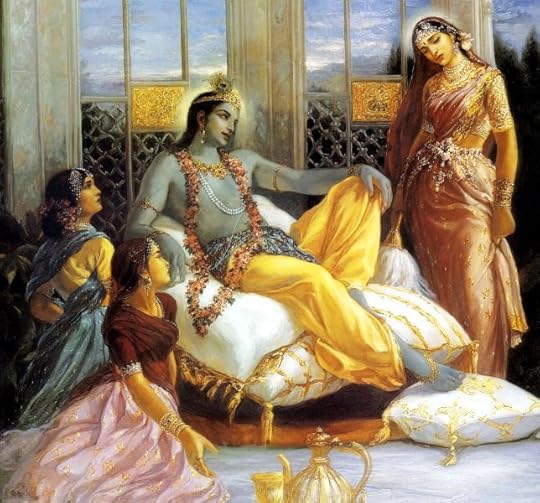
If Dwarka excavations can throw light on the historicity of Lord Krishna, sea-bed excavations at Ayodhya
situated on the banks of Sarayu might yield equally valuable
information about the historicity of Lord Rama.
We, the youth of the country should participate more in spreading the knowledge of our ancient heritage and endeavor to be a part of a further exploration of its origins. Only then, we would be able to unearth the true history of our own civilization as well as that of Mankind.
.
Aum Shanti: Shanti: Shanti:
.
Published on October 01, 2012 12:53
August 31, 2012
Pralaya - The 'End of Days'
Some say the world will end in Fire; Some say in Ice,
From what I've tasted of desire, I hold with those who favor Fire.
But if it had to perish twice, I think I know enough of hate,
To say that for destruction, Ice is also great!
End of the World - How does the term sound?
For me it conjures up something abstract.. an inconclusive conclusion fashioned from the catastrophe-centric best-sellers churned out of Hollywood and the Doomsday predictions of a few ancient mythologies.
God decides to End our Days
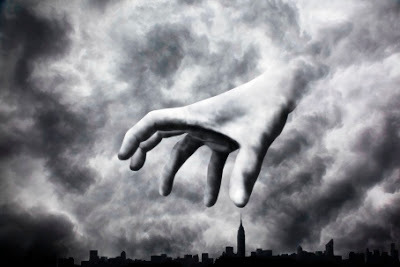
Assuming that it happens within our lifetimes, how would the world end indeed? A lot of people believe, it would happen because of a Nuclear War .
A very plausible scenario a decade ago but currently the chances of that seem a little less. It may still come to pass as we have varying degrees of religious fanatics running around the globe with secret stashes of atomic-missiles obtained through illegitimate means.
A Nuclear Cloud obliterating Life

Others believe, the world would end because of a Meteor crash.
This again is a possibility as there are loads of meteors hurtling past Earth everyday in their journey around the Sun. From time to time, one or the other of these meteors keeps scaring the scientists with its proximity to Earth. It has happened in the past (when the Dinosaurs were wiped out 65 million years ago) so the chance of that happening again can not be ruled out!
Armageddon Arrives

Others, believe in Global Warming or Earthquakes triggering a Great Deluge that would submerge the entire landmass and drown everything in its colossal Tsunamis.
This again is a decent possibility since we have been observing the melting of Antarctic Ice sheets and frequent Earthquakes in the sea-bed. The Tsunamis that hit south-east Asia few years back reminded us of how fragile our relationship with nature is!
Drowning of the Earth

All these, I must confess, are possible and extremely PROBABLE events that may happen anytime in our future.
Yet, as mentioned by Robert Frost in the beginning of this post, I believe its Ice that is destined to wipe out the entire civilizational progress of Humanity and that too in a not too distant future!! There is a reason why MY preferred Modus Operandi (if you can call it that) of Destruction is ICE and in the current post, I'll share with you descriptions from ancient scriptures to support the argument.
End of the World in Hindu Mythology
Strictly speaking, Hindu Mythology does not believe in a SINGLE event of destruction of the World, or even a SINGLE event of creation for that matter.
As discussed in the Page { Kalchakra } of this blog, Time in Hinduism, is not Linear i.e. it doesn't start and end at specific points, rather, it is Cyclical and never-ending. This eternal cycle of Life and Death; Birth and Re-birth; Formation and Dissolution is called the Kaal-chakra or the Wheel of Time .
The Cyclical Destruction of the World as we know it, occurs in events singularly known as a Pralaya that takes place at the end of a Chatur-Yuga . A cycle of Four Yugas is known as a Maha Yuga or a Chatur-Yuga and at the end of this cycle, our Earth experiences a cataclysmic event which has the capacity to wipe out all life from the face of the planet.
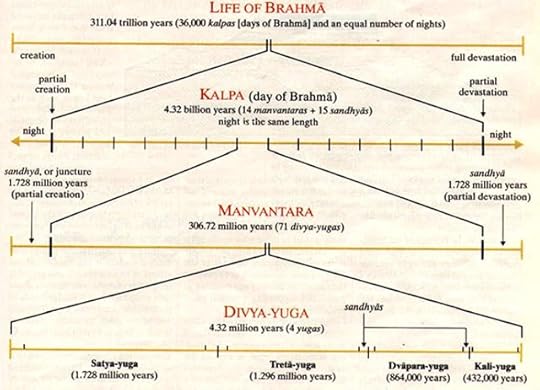
Ancient Puranas detail this concept further and describe different types of Pralayas:
A Pralaya at the end of a Chatur-Yuga (every 4.32 Million Solar Years),
Manvantar Pralaya at the end of the rule of each of the Manus (every 307 Million Solar Years),
Naimittik Pralaya at the end of the Day of Brahma (4.32 Billion Solar Years) and lastly,
Prakritik Maha Pralaya at the end of Brahma's Lifetime (311.4 Trillion Solar Years)!
Leaving the latter three for later, let us first see how the tiniest of these, the Pralaya looks as this seems the most likely candidate for the 2012 Doomsday predictions.
Description of Pralaya
In various Puranas, the description of Pralaya that happens at the end of a Chatur-yuga is extremely applicable to what is referred to as the Great Deluge in Biblical and Koranic references.
In these as well as the Hindu legends of Manu, entire Earth was inundated by Water which swallowed up the land and gobbled up most living as well as non-living things surviving on it. In all the three traditions, ONE Man was chosen by God to continue the legacy of Human race.
In Hinduism, this man is Vaivasvat Manu and in Biblical references he is called Noah . We have learnt more about him already in a previous post { Manu - The First Man }.
The belief in a Great Deluge is not limited to the three above mentioned religions alone.. it was widely believed by a lot of ancient mythologies as well viz:
In Sumer and Babylonia Atrahasis, Ziusudra, Xisuthrus and Utnapishtim are the different heroes credited with the same feat as Manu. Each of these is credited hoarding with cattle, wild animals and birds on the boat to constitute “the seed of all living creatures” in the next Eon.
According to Tibetan legends, Tibet was almost totally inundated, until the god Gya drew off the waters through Bengal, and sent teachers to civilize the people, who repopulated the land.
In the Ifugaos of Philippines and the Kammu of Thailand, a brother and sister were the only survivors after the flood and they were responsible for populating the Earth with different races.
For the Batak of Sumatra, the giant snake on whose head Earth rests, Naga-Padoha (Hindu Shesh-Naag? ), grew tired of its burden and shook it off into the sea. But the god Batara-Guru caused a mountain to fall into the water to preserve his daughter and the human race is descended from her.
In Egyptian mythology, Set sent forth the deluge to destroy the evil Sebau, the Sami, the Apap-dragon ( Hindu Vrtra ) and the long-armed ones. There is another story, about Horus steering his ark across the cosmic ocean as six poles are capsized leaving only the seventh one as dry land, upon which he rested.
Egyptian god Horus in his ship
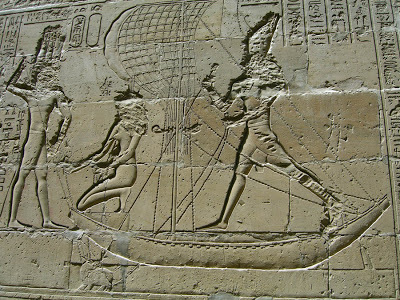
In the Greek myths, Zeus sends a flood to destroy all of humanity but Prometheus warns his son, Deucalion , about the coming deluge, and advises him to build an ark.
In Norse mythology, the flood occurred at the dawn of time before the world was formed. Ymir, the first giant, was killed by the god Odin and his brothers and his blood drowned almost the entire race of giants with the exception of the frost giant Bergelmir and his wife. They escaped in a ship and survived, becoming the progenitors of a new race of giants.
The Frost giant Bergelmir
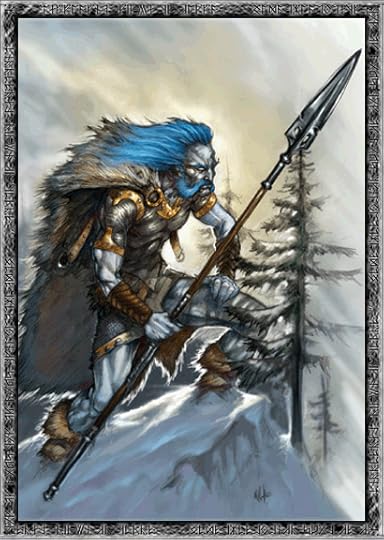
According to the Quechua Native Americans, a llama tells his human owner about an impending flood and saves him; for the Mayans, the gods used a flood to destroy the wooden people, an early imperfect version of humanity.
Similar beliefs are echoed by the Shaur of Andes, the Caddo of Texas, and the Hopi.
The Michoacan of Mexico have the same story as Manu and the hero here is a guy called Tezpi . The Tarahumara and the Toltecs of Mexico also have their own versions of the flood myth.
The Nahua of central Mexico talk about a man known as Nata (“Our Father”) and his consort Nene who were protected by their God at the time of flood while the Mixtec of northern Oaxaca, Mexico believed that the earth was once well populated, when mankind committed a magical fault for which they were punished by a great deluge.
A Native American survivor of the flood

In New Guinea legends, Lohero and his brother were angry with their neighbors, so they put a human bone into a small stream. Soon a great flood came forth, and the people had to retreat to the highest peaks until the sea receded.
In Africa, the Kwaya residing around Lake Victoria believed that the ocean was once enclosed in a small pot kept by a man and his wife which was by mistake shattered by their daughter-in-law, and the resulting flood drowned everything.
The Yoruba of southwest Nigeria talk about an adro-gynous god Olokun who in a fit of rage, destroyed nearly everybody in a great flood.
Olkun, the Orisha who flooded Earth

For the Vogul after seven years of drought, the Great Man counseled the other giants to make boats from cut poplars, anchor them with ropes of willow roots 500 fathoms long, and provide them with seven days of food and with pots of melted butter to grease the ropes. Those who did not make all the preparations perished when the waters came.
In North-central Siberia, Yenisey-Ostyak believe that during the seven day flood some people and animals were saved by climbing on floating logs and rafters. A strong north wind blew for seven days and scattered the people, which is why there are now different peoples speaking different languages.
According to Tuvinian tails of Mongolia, the giant frog (or turtle) which supported the earth moved, which caused the cosmic ocean to begin flooding the earth. An old man who had guessed something like this would happen built an iron-reinforced raft, boarded it with his family, and was saved.
There are hundreds more from around the world, from various tribes and cultures, and so this is just a handful. What could have caused these Geographically separate civilizations to form such a common belief?
The answer according to me, rests in Ice, or more specifically, the Ice-Age . It is MORE than likely that all the above myths refer to the same phenomenon, one which we scientifically KNOW to have taken place - that of the Ice Age.
There have been at least five major ice ages in the Earth's past. The earliest well established ice age, called the Huronian , formed around 2.4 to 2.1 Billion years ago and the latest one started about 2.58 million years ago when the spread of ice sheets in the Northern Hemisphere began!
Since then, the world has seen cycles of glaciation with ice sheets advancing and retreating on 40,000 and 100,000 year time scales called Glacial periods , and Glacial retreats called the Interglacials . We are currently in an interglacial, and the last glacial period ended about 10,000 years ago.
We saw in the post { Heaven at the North Pole } that the Arctic region had a temperate climate, quite conducive to the growth of plant and animal life before the Ice-Age set in. In the same post, I also mentioned the possibility that at least some of the Vedic seers and magi had lived in the Arctic area in close proximity to their Gods who dwell on Mount Meru.
But everything changed 20,000 years ago when extensive ice sheets covered large swaths of Northern and Southern Hemispheres. Consequently, whatever civilizations were existing before, were forced to migrate to warmer places or perish.
North Pole during the last Ice Age

But that was not all, the real trouble would have begun when ALL this Ice began to MELT!
During Ice-Age, water was taken from the oceans to form the ice, thus Global Sea-levels must have dropped, forming bridges between land-masses for animals to migrate. However, during Deglaciation , or Meltdown, the ice-water returned to the oceans, causing the SEA-LEVEL to rise by as much as 110-120 meters!!
Pre-glacial US coastline

Pre-glacial coastlines in Australia

Pre-glacial India and S-E Asia
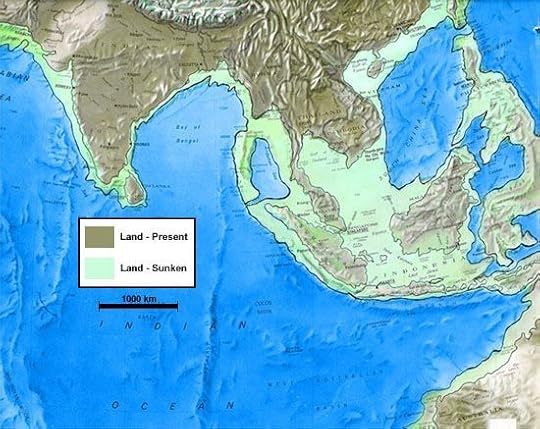
In fact, Tamil Sangams talk about a sunken land extending right from Kanyakumari to Madagascar in the West and Australia in the East that got sunk in the deluge!
Kumari-Kaandam

And what can be the result of such a meltdown?? Of course we get what is theologically labeled as The Great Deluge !!
Throughout our history, the busiest cities have been located either on the banks of mighty rivers or near busy coastlines. All the melted ice lead to a RISE in sea-levels, inundating huge chunks of land and ALTERING the shape of the planetary landmass.
Consequently, there would have been wide-spread displacement of people and populations leading to probably the BIGGEST catastrophe in the History of Human civilization. No wonder then, that mythologies from such different parts of the World narrate the same story!!
The existing hubs of civilization were inundated and the tracts of land connecting different continents too got submerged altering the course of our history. A case in point is the Bering Bridge which was the landmass connecting Russia to America. This small tract of land performed a vital function as numerous species
of animals, as well as the ancient humans migrated to and populated
the American continent through the same bridge!
The Bering Strait replaced the bridge of land connecting Russia to America

The Migration route of Homo sapiens into America
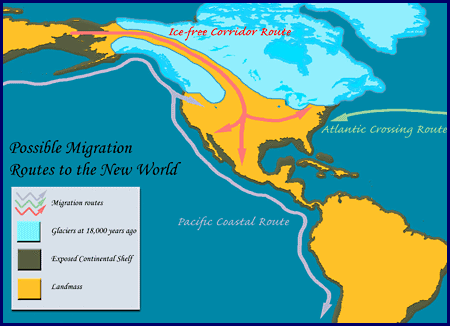
If the inundation of such a tiny piece of land could have such immense effect, imagine the condition when major civilizational hubs on the planet would have undergone submersion under the super-massive TSUNAMIS!!
As such a catastrophe would lead to major uprooting of people and populations all over the world, it can very well explain the presence of the SAME LEGEND in widely differing Geographical locations!
Water reclaiming Land during the recent Tsunami

The flood waters would wipe clear all evidence of civilization from the face of Earth leaving only a few stranded pockets at the highest altitudes of the Planet! One such place is Manali high in the Northern Himalayas where the Ark of Vaivasvat Manu is believed to have docked.
There are other explanations given by the scientific community for the Great floods, ranging from Meteor crashes to Volcanic eruptions.. However, it is the CYCLICAL nature of the Ice Ages along with their capacity to generate GLOBAL FLOODS that prompts me to co-relate them with the Pralaya myths from Hindu Mythology!
And as far as cyclicity goes, already, many scientists predict a coming of the next Ice Age as we may have reached the end of the current period of Interglacial interval. The predictions have created a lot of debate and not surprisingly, there have been major movies based on the same theme.

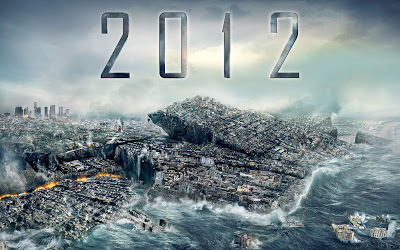
2012 Predictions in Hindu Mythology?
By ancient Hindu calculations,
there are still close to 4 lakh 30 thousand years left in this
Kaliyuga!! How does the Mayan prophecy of the 'End of Days' fit in with this
long timeline?
By Aryabhatta's calculations, Kaliyuga
began between 18th to 20th February 3102 BCE which would mean we have
utilized about 5270 lunar years or 5113 Solar years from the time when
the Kali Yuga started
until 20 Dec 2012.
Interestingly, the Mayan calendar started close to this date in 3114 BCE. The only other connection I could find with this
time period in Hindu mythology is an excerpt from the Brahma Vaivarta
Puraan where Shri Krishna tells Goddess Ganga that she would be the
source of cleaning mankind' sins in the first 5000 years of Kaliyug -
Shri-bhagvaan uvaach -
Kaleh pancasahasrani varshani tishtha bhutale,
Paapani paapino yani tubhyam dashyanti snanatah!
After that, it would be only the name of Hari and the association of His devotees that can purify impure souls and take them back to Godhead. In verse 59, the Lord also says,
Kaler dash-sahasraani
madbhaktaah samti bhu-tale
ekavarna bhavishyamti
madbhakteshu gateshu ca
For
10,000 years of Kali,
such devotees of Mine will fill the whole planet.
After the departure of My devotees there will be only one varna."
This would imply that the Kaliyug will last at least 5000 years more! Interestingly, many scholars also claim that the end of the Mayan
calendar in 2012 could reflect the Mayan's inability to calculate the
calendar any further instead of a literal END of days. It could also
mean that the Mayans probably got bored of this astronomy and were not
interested in calculating calendars further ahead :o)
This would mean that 2012 does not mark the End-of-Time but the End-of-an-Age thereby signifying a phase of transition and nothing more or less than that.
The conversation from the Brahma Vaivarta Puraan mentioned above could indicate that river Ganges will cease to be the Purifying Agent it currently is, which BTW, is very believable since we have been dumping collective wastes amounting to tons into it every single day and there's only so much the river's Bacteriophages can take care of!
The Ganga may lose its sanctity because of our actions

BUT it could ALSO mean something more sinister! As our violent earthquake-prone history has proved, Ganges might go through some major tectonic change and disappear like Saraswati {Check the post - Finding River Saraswati for more details}. If that happens it would be catastrophic for millions of people living on the banks of the river!
Irrespective of whether that happens or not, we should realize the RELATIVITY of this concept. What does the 'End of the World' mean to a person killed in a terrorist attack? What does it mean for a mother who has lost her firstborn? What does it mean for a child kidnapped or sold into slavery and prostitution? When does the World end for a black-buck in the jaws of a leopard or a rat in the coils of a serpent?
Every grain of Time brings with it either Creation or Destruction. The eminent Austrian Physicist Fritjof Capra, in his monumental work { Tao of Physics }, calls it the Dance of Shiva . As each atom is created, another is destroyed and this continues forever in a cyclical manner.
Tandav - the Cosmic Dance of Shiva

Everything we amass in this life will all be taken away one day by the hands of Time. The same thought must have inspired Oppenheimer, Father of the Atomic Bomb to quote Lord Krishna, from the Bhagvad Gita - Time, I am, the Destroyer of All.
The sooner we realize the transient nature of all existence and start on the Path of Spirituality, the easier it would become to deal with that 'Final Moment' in the End. I conclude this post with the same sentiment expressed in the words of a 6th Century Sanskrit Poet Bhartrhari:
A Hundred Years complete our span,
And Half of that is passed in Night,
Childhood and Old-age devour the Half,
Of what belongs to Light.
The rest is torn with parting pangs,
Of ceaseless toil the Slave,
What profit is our Human Life,
Unstable as a Wave.
Our Bloom of Youth decays,
Our Joys are brief as lightning flash,
And in Summer's cloudy days,
Our riches fly away and crash.
Faith in the One Supreme,
Alone will bear us over the Chasm,
Of Existence's Stormy Stream,
And Maya's elaborate Phantasm.
.
Aum Shanti: Shanti: Shanti:
.
Published on August 31, 2012 04:37
June 21, 2012
On Wings of Fire
The fire in a Hearth, that cackles and burns,
Is a remnant of Life, of Ashes and Urns,
Stored in trees, by breaths of the Sun,
Life giving Life, the Wood bakes the Bun..
Fire, one of the FIVE essential elements or the Panch-Mahabhoot of Hinduism; the element that brings fold images of immense energy; the element that gave humanity the chance to survive; the element that would ultimately destroy everything at the end of Time.
Even though it may appear predominantly Destructive, Fire is a Constructive force which has quite literally ignited the development and growth of Human species. Almost single-handedly, the taming of this devastating force of Nature, led Humanity away from its dark origins and helped in the development of Culture and Civilization.
From Darkness to Light
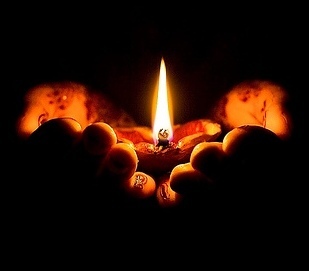
In this post, I would take you through the origins of the use of Fire by early man and the role it played in the development of Civilization as we know it. We will also take a look at the role it plays in various World mythologies including our own.
The Life before Fire
A report published in 2010, in the Proceedings of the National Academy of Science , shows that there was a very real risk of extinction for our ancestors.
The study declares that the effective population of humans living 1.2 million years ago was just about 18,500. This implies a really really tiny population size, especially if you compare with the population sizes of chimpanzees (21,000) and gorillas (25,000) during the same time period!!
Man was in fact quite vulnerable - he was poorly insulated because of no fur; had nails and teeth unsuitable for defense or hunting; and was completely ill-equipped to tolerate the fluctuating extremes of the Climate. Left on our own, we might have PERISHED like numerous other species in the history of our planet! What changed our fate was the 'Discovery of Fire'.
Early Man probably first encountered bush-fires in summers or lightening strikes that set fire to tall trees. It would have taken him some time to actually get control of it and even more time to actually PRODUCE fire on his own.
Forest Fire, probably the First form of Fire encountered by Early Man
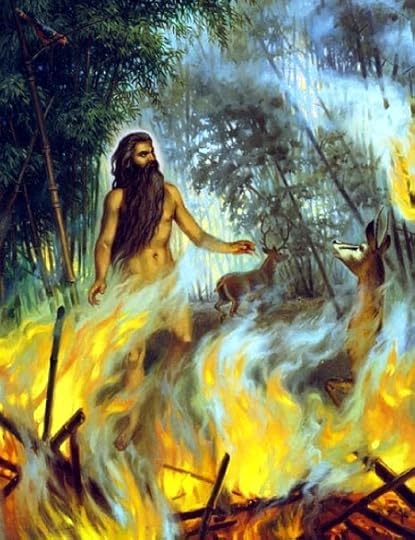
Claims for the evidence of use of fire by various species of Hominids are made from almost 1.5 million years ago (mya) however, most historians believe that the controlled use of fire started with Homo erectus some 400,000 years ago.
You light my Fire!
Once tamed, Fire helped early man ward off the DARKNESS that tormented him at night. It provided him security and let him survive in the harshest WINTERS especially during the ICE-AGEs.
Fire provided PROTECTION from dangerous predators and kept them at bay. It facilitated the conversion of forests into FIELDS and helped bake UTENSILS and forge TOOLS. Fire let human-beings COOK food and make it more edible, a feat which most scholars agree led to various modifications including some in our anatomy.
As human diet became easier to chew and swallow, the tooth size decreased and the jaws became less prognathic or ape like. There was also the shift from eating-in-the wild to eating-in-the-kitchen which further strengthened the community bond and led to the appearance of the first rudimentary Hearths and Homes.
Communities evolved by eating together
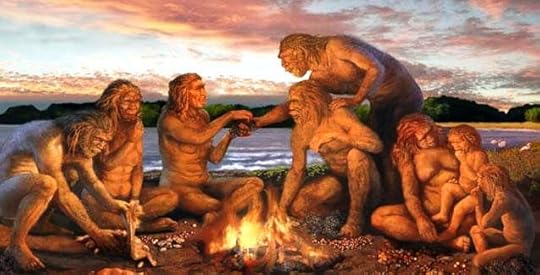
Humans could now stop worrying about defense and safety and use their brains for development of new ideas. Both directly as well as indirectly, Fire initiated INDUSTRY and has led mankind to the EXPLORATION of Space, the Final Frontier.
Therefore, it is not surprising, that the Early Man developed deep reverence for this Primal force of Nature. In fact, some World Mythologies worship Fire as the Supreme God Himself. Let us explore some of these beliefs and understand the importance it held in the life of the ancients.
Worshipping the Fire-God
The Sanskrit word for Fire is Agni and this consequently, is the name of the Fire-god as well.
Most of you would be aware that fire-lamps forms an integral part of Hindu rituals. We see fire being offered to the deity at prayer time; oblations being put in the sacrificial fire of a Yagnya ; the seven promises of a marriage ceremony being made circum-ambulating the witness fire; diyas being lit for Diwali and so on...
Rig-Veda, places Agni second only to Indra in importance and we find 1/5th of Rig Vedic Hymns dedicated to the Fire-god! In fact, the very 1st verse of the Rig-veda is dedicated to Agni:
अग्नि॒म् ई॑ळे पुरो॒हि॑तं यज्ञ॒स्य॑ देव॒म् ऋत्वि॒ज॑म्। होता॑रं रत्नधा॒त॑मम्॥
Agni I laud, the High-priest, Invoker, Minister of Sacrifice, Deva and Bestower of Wealth
Agni is represented with TWO faces, suggesting his destructive as well as beneficent qualities. He has THREE legs which represent the three worlds that it is present in and SEVEN arms that represent the seven directions that he covers.
He rides a ram, or a chariot pulled by goats which probably is a reference to the use of these animals for sacrifice. Interestingly, most forms of fire-worship in Graeco-Roman religions also involved burning the sacrificed animal on a fire-altar in front of the temple.
Agni, the First god worshiped in Rig Veda
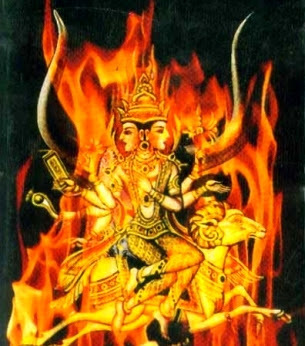
Agni is described as the son of Dyaus Pita and Prithvi Mata and hence Indra's twin, both of them performing complimentary functions. While INDRA transmits energy to the Earth in the form of his thunderbolt, AGNI takes energy from the Earth to the Heavens in its swirling smoke.
Rigveda surprisingly, also mentions that 'Agni dwells in the waters' and may even be born from it! This may appear confounding till we think of fire arising from lightening-strikes, natural gas surfacing through water, or even the under-water volcanic eruptions! Because of the same reason, the Persians therefore referred to him as Apam-Napat.
Accordingly, there are said to be Ten different forms of Agni :
Regular Fire,
Sacrificial Fire produced by rubbing the fire-sticks ( Arani or Idhma ),
Initiation Fire at Upanayana ceremony of a child coming of age,
Fire kept in the house for Domestic rituals,
Fire spread by Lightening,
Fire in the Sun,
Southern Fire for ancestors,
Funeral Fire used for cremation,
Digestive Fire ( Jatharagni ), and the last but most potent of all,
Destructive Fire or Davagani that initiates the process of Maha-pralaya.
In Ayurveda , Agni is the first guardian of health and manifests through “Jatharagni”, the digestive fire. Each time we eat, we are in a sense making an offering to the digestive fire and these offerings are transformed into nutrition or Prana for the body.
Agni is also appointed as one of the Ashta-digpals and is the guardian of the South-East direction. His wife is Svaha and his sons are Pavak, Pavaman, and Shuchi, who according to the Vayu Puraan , stand for Electric fire, the fire produced by Friction, and the Solar fire respectively.
Svaha 's name is mentioned each time an offering is poured into the sacrificial-fire. This suggests that the husband-wife duo is to be appeased together and reflects a rarely researched proximity between the two..
Agni and Svaha from a Mughal miniature painting
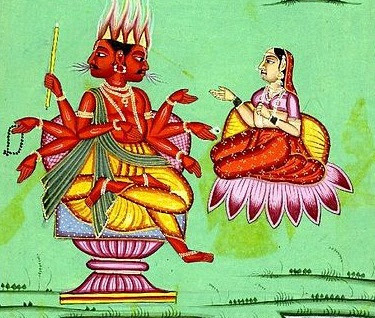
The legends talk about a messenger of Surya, Matarishwan (identified in the Upanishads as Vayu ) who brought the secret of controlling Fire down from the Heavens and gave it to the ancient Bhrigus for safe-keeping. .
This reminds me of the Greek myth of Prometheus where fire was stolen from the King of Gods Zeus and given to Man. As a punishment, Zeus chained the Titan to a rock on the Caucasus mountains where the giant eagle Ethon would eat at his Liver everyday!
Prometheus being punished for bringing Fire to Man

It is in stark contrast to the Hindu legend where Gods themselves send Fire for the benefit of Humans, but probably highlights the gods' concern that Humans probably can not handle such immense power. I, for one, wouldn't blame them for such a thought ;o)
At this point, let us take a look at Fire-worship in the other World Mythologies as well.
Fire-worship in different mythologies
Did other civilizations also venerate Agni to the extent that the Vedas do? Indeed there appear to be numerous references linking fire to God in various world traditions.
In Native American traditions, Fire is the eldest family member and ancient dwelling of Spirit.
Aztecs worshiped the turquoise-colored god Xiuhtecuhtli, as the 1st Lord of Creation and the god of Fire, Day and Heat.
The Incas venerated a fire-god known as Manco Capac, who was created by the Sun-god Inti and was the first king of the Incas.
The Aztec Fire-God Xiuhtecuhtli

In Norse mythology , there exists a World of Eternal Flame called Muspelheim , which is ruled by Surtr the fire-giant who is the personification of Fire.
In Slavic mythology , the spirit of fire is known as Svarog .
Surtr, the Norse Fire-giant

In Jewism the Supreme God Yahweh Himself manifested as a pillar of fire to guide the Israelites out of the Pharaoh's land (reminds me of the story where Shiva appeared as a pillar of Fire).
Moses got the Ten commandments from a burning bush, Elijah ascended to the heavens in a chariot of fire and the Menorah or the seven-branched ancient lampstand made of gold has been the symbol of Judaism since ancient times.
Yahweh guides Moses and his people in the form of a pillar of Light
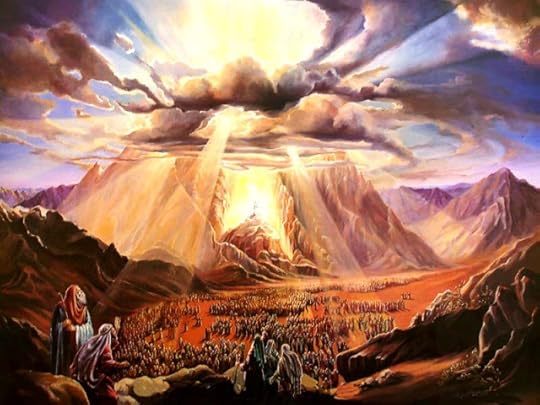
In the Roman/Greek traditions, Fire had two separate forms: one of the 'Hearth' and the other of the 'Forge'.
Hearth worship was dedicated to Goddess Vesta , protector of the home, who had an eternal sacred flame tended to by Vestal Virgins in the city of Rome.
Vesta, the Roman goddess of Hearth and Home

Closer home, Atar is the Parsi concept of H oly fire . In Yasna 17.11, Atar is the Master of the house, and it is only with its assistance, the other six creations can begin their work ( Bundahishn 3.7–8; and Zatspram 3.77–83).
Zoroastrians evidence of fire-worship exists from around 1500 BCE, together with the first evidence of cremation. The tradition is still followed in the Indo-Iranian branch of Hindus where Agni is considered an agent of purity.
The Greeks also used to cremate their dead like the Hindus instead of burying them in graves. Probably the Biblical statement 'Ashes to Ashes; Dust to Dust' also stems from the same tradition.
Agni, the First Priest
Agni, is called the First and Foremost of the Priests. He is a friend of the humans and always within reach.
In Hinduism, Fire-sacrifices hold a very important place. The Bhagavat Puraan declares Yagneshwara (Lord of yagya) to be an incarnation of Lord Vishnu, and Dakshina (donation), the embodiment of Goddess Lakshmi as his consort. Thus, performing a Yagnya is equivalent to appeasing Lord Vishnu.
A Vedic Yagnya in progress
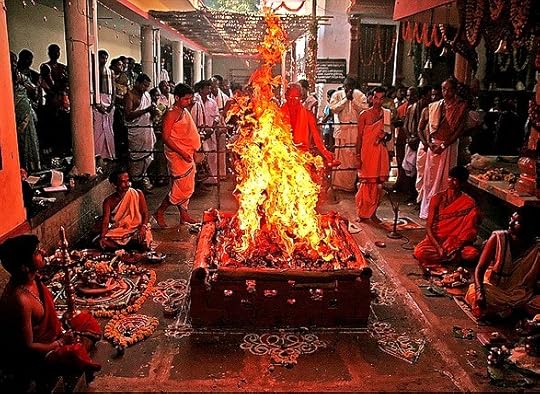
Agni is worshiped in Rig Vedic verse 5.3.1-2 as the embodiment of all gods. He is the priest who prays to other demigods on behalf of humans; he is the officating priest of a Yagnya; and lastly, he is the bestower of the gifts of gods to us humans.
Accordingly, the human priests are also classified into three categories based on the roles they play in a Yagnya - Hotri, Adhvaryu and Udgatri . The Sacrifices performed could be of various types depending on the intended beneficiary.
For example, a Brahma-yagnya is performed to please the Supreme Brahman, while a Dev-yagnya aims to appease the Devas. A Pitri-yagnya is performed for the benefit of the Ancestors, Manushya-yagnya for that of men and a Bhuta-yagnya for the benefit of all life forms.
A Deva-Yagnya being performed to appease the Devas
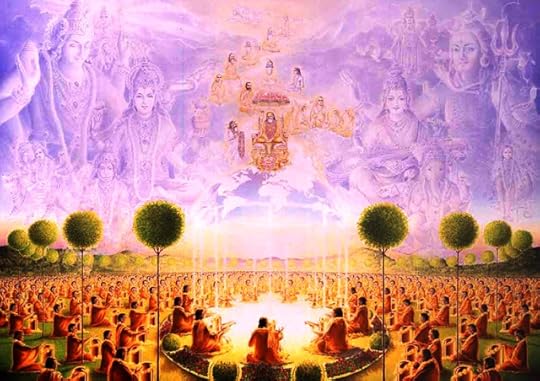
There are numerous instances of special Yagnyas being performed by the Kings and Emperors of yore in order to fulfill their desires. Some examples are the Putra-kameshthi Yagnya performed by Dashrath and Yuvanashva; the Ashwamedh Yagnya performed by Lord Rama and the Rajasuya Yagnya undertaken by the Pandavs.
Rishi Kashyap obtained Garuda, a son stronger-than-Indra through a Yagnya while Draupadi, the nemesis of the Kuru family, and her twin brother Dhristadyumna also emerged from the sacrificial fires of Drupad's Yagnya.
Agni is also chronicled as the bestower of advanced weaponry and he gifted Shri Krishna and Arjuna the Sudarshan Chakra and Gandiva bow respectively after they helped Agni get back his glory. Similarly, the demon-king Bali Maharaj obtained invincible armour and chariots by means of a Yagnya and was able to defeat Indra with their help.
Agni, the Celestial Witness
Shukla Yajur Veda 21.3 refers to Agni as the 'Master of all branches of Knowledge'. He is believed to be the symbol of righteousness and truth and hence appointed the witness and the priest for all Vedic ceremonies.
This position he attains by virtue of being present in all the Three Worlds at all times, in all the dwellings of the sentient beings. Because of this unique presence in all spheres of life, Agni is the ideal witness in case of disputes. Therefore, in ancient India, promises were made and agreements solemnized in front of a sacred fire. For the same reason, Agni is also the witness of a Hindu Marriage Ceremony.
Hindu marriage ceremony performed with Agni as the witness

{Image courtesy - Imagesbazaar}
Because of this omniscience, Agni was also made the arbitrator of disputes that couldn't be settled by human intellect. The most important example is that of the Agni-Pariksha of Lady Sita.
Many people today criticize the incident giving it a chauvinistic tinge, but the truth is that in ancient times, Agni was the Highest Judge (somewhat like the Chief-justice of our Supreme Court today!). Those were the times when Devas and Asurs freely intermingled with humans and it was not uncommon for a human of good standing to call upon Agni as his witness.
The process is more elaborately detailed in Zoroastrian texts which describe Fire as Atar and a medium through which judgement is passed. This ordeal-by-heat is known in Avesta as Garmo-varah.
An individual who has passed the fiery test, has attained physical and spiritual strength, wisdom, truth and love with serenity Yasna [30.7]. Atar is spoken of in the third person masculine singular: "He detects sinners by hand-grasping" Yasna [34.4] and altogether, there are said to have been 30 kinds of fiery tests in all!
Till now, we have seen the benign and beneficient properties of Agni, let us now take a look at the destructive aspect of his personality.
Fire as the Destructive Force
The most potent representation of the destructive poweres of Agni is seen in the Rudra manifestation of Shiva when the Third Eye of Shiva opens to release a laser beam of destrucion.
Legend has it that Parvati, the daughter of Himalayas fell in love with Shiva. She performed severe penance to obtain the Lord as her husband and was unknowingly supported by the demigods in this endeavor .
Kama, the god-of-love, and his consort Rati tried to draw Shiva into the charm of Parvati's beauty but Shiva was in no mood to be swayed from his penance and in His anger, he opened his Third Eye and incinerated Kama to ashes!
Kamadev is reduced to ashes by Shiva's glare
Fire released from Shiva's Third Eye
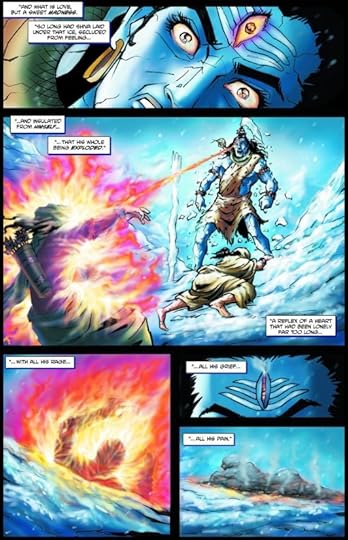
{Image courtesy - India Authentic}
Issue - Uma
Therefore, one of the epithets of Kamdev is Anang or bodiless. By destroying his body but letting his soul remain, Lord Shiva highlighted the supremacy of spiritual LOVE over physical LUST. (The story later had a Happy ending when Shiva was finally united with Parvati and Kama reborn as Krishna's son Pradyumna was re-united with Rati.)
Shiv Purana [2.3.20.14-19] states that the fall off of this energy fell like lightning from Shiva’s third eye and Brahma had to take it to the ocean and keep it safe there else it would have burnt the entire creation. This mare shaped sub-marine fire at the bottom of the ocean, is known as Vadava.
Normally, the fire is kept in check with the waters of the Global Ocean. But as Mahabharat verse 12.248.13-17 state, the end of the Day of Brahma is nigh that Rudra sparks off the fire again and this explosion of fire from the mare's mouth in the Southern Ocean will begin the process of Pralaya.
Could this sub-marine fire actually refer to underwater volcanoes that keep spewing out magma from the Earth's core. Maybe the end of our days will be initiated by an under-water volcanic eruption that sets a chain of events in motion leading to the annihilation of life as we know it!
Under-water volcano eruption
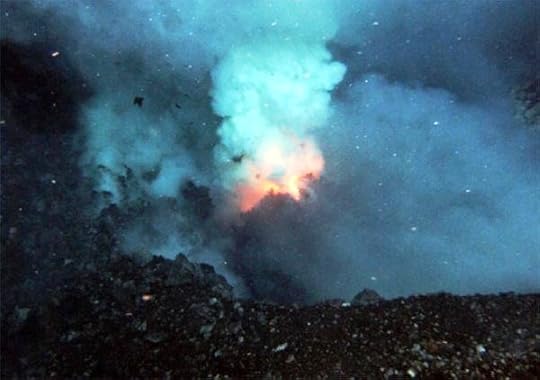
Interesting possibility and we shall dwell on it in a later post. For now, let us thank Agni, the catalyst of our development and conclude this post with a homage to him by Shri Chinmoy.
Agni, the Hindu-god of Fire
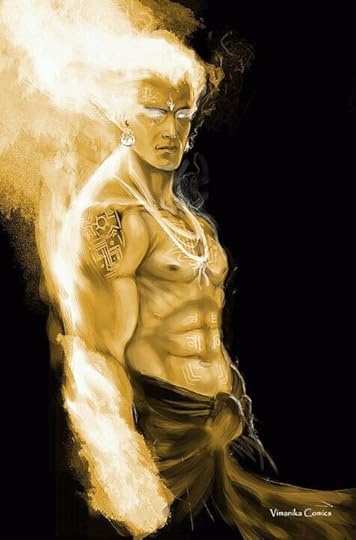
{Image courtesy Vimanika Comics}
O Light of the Supreme!
Kindle the flame of Liberation within me,
Pour down the ocean of Compassion,
Into my heart,
You are my Immortality,
Accept my Darkness, Bondage, Ignorance, Death;
And release me from this Mortal frame.
.
Aum Shanti: Shanti: Shanti:
.
Published on June 21, 2012 01:27



